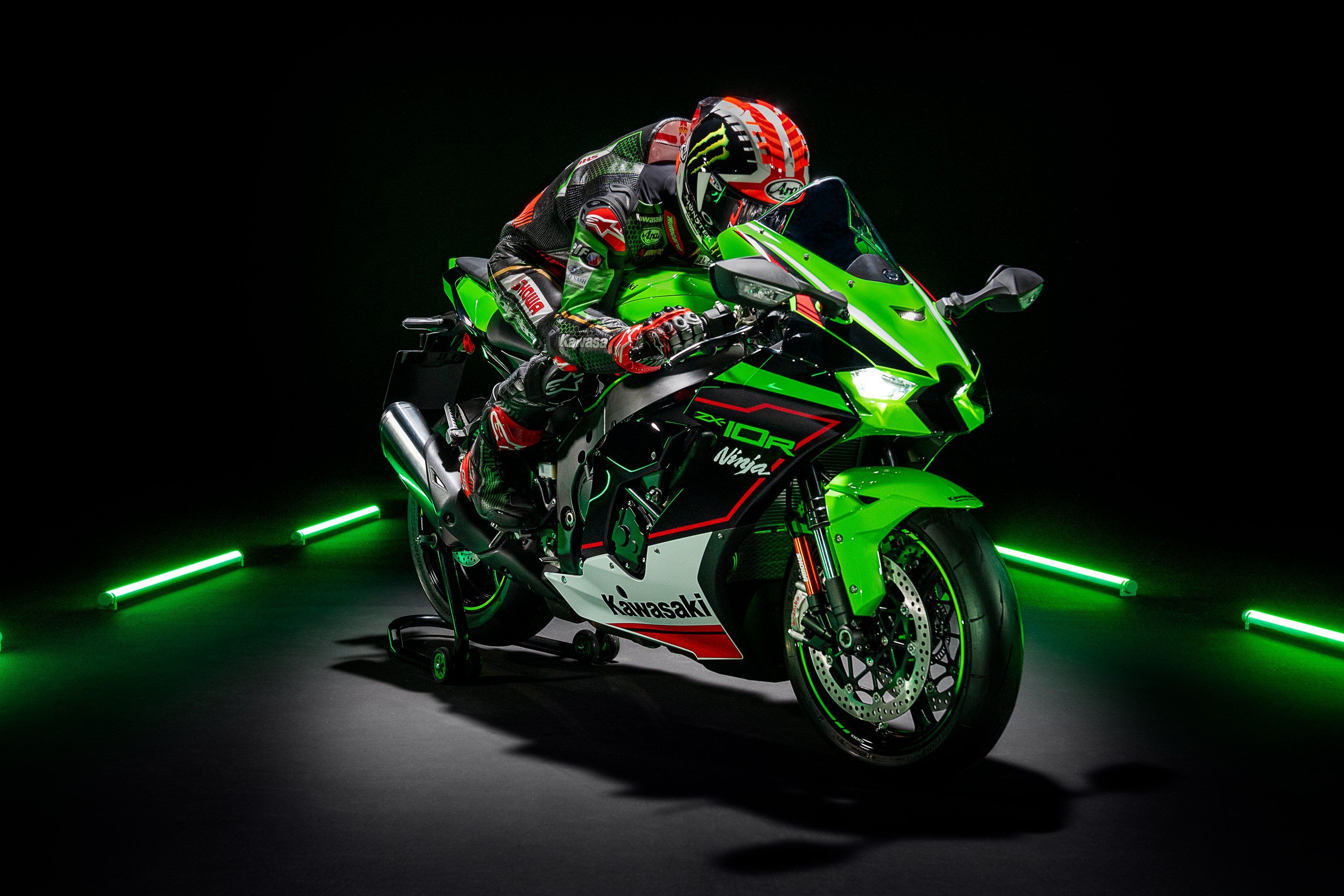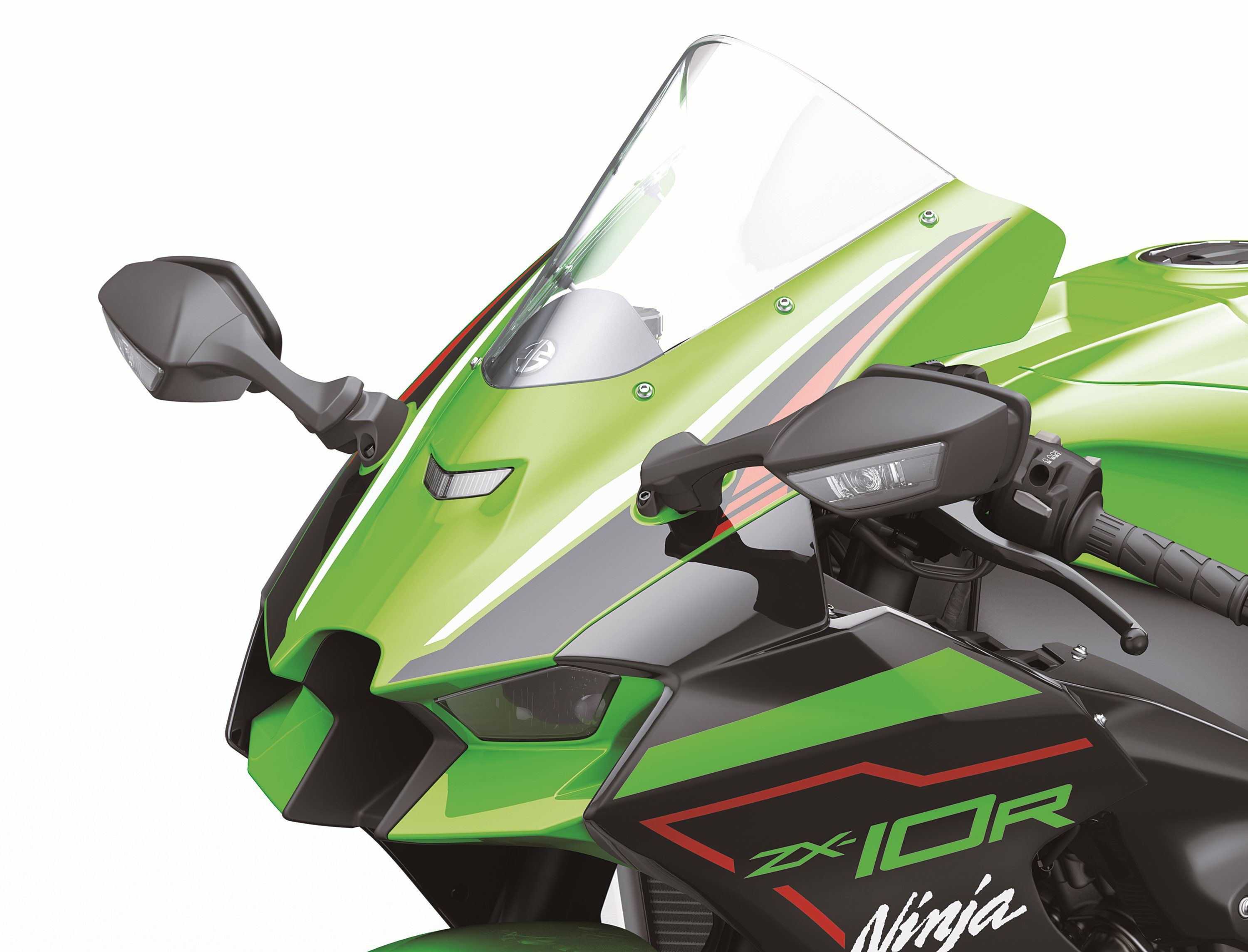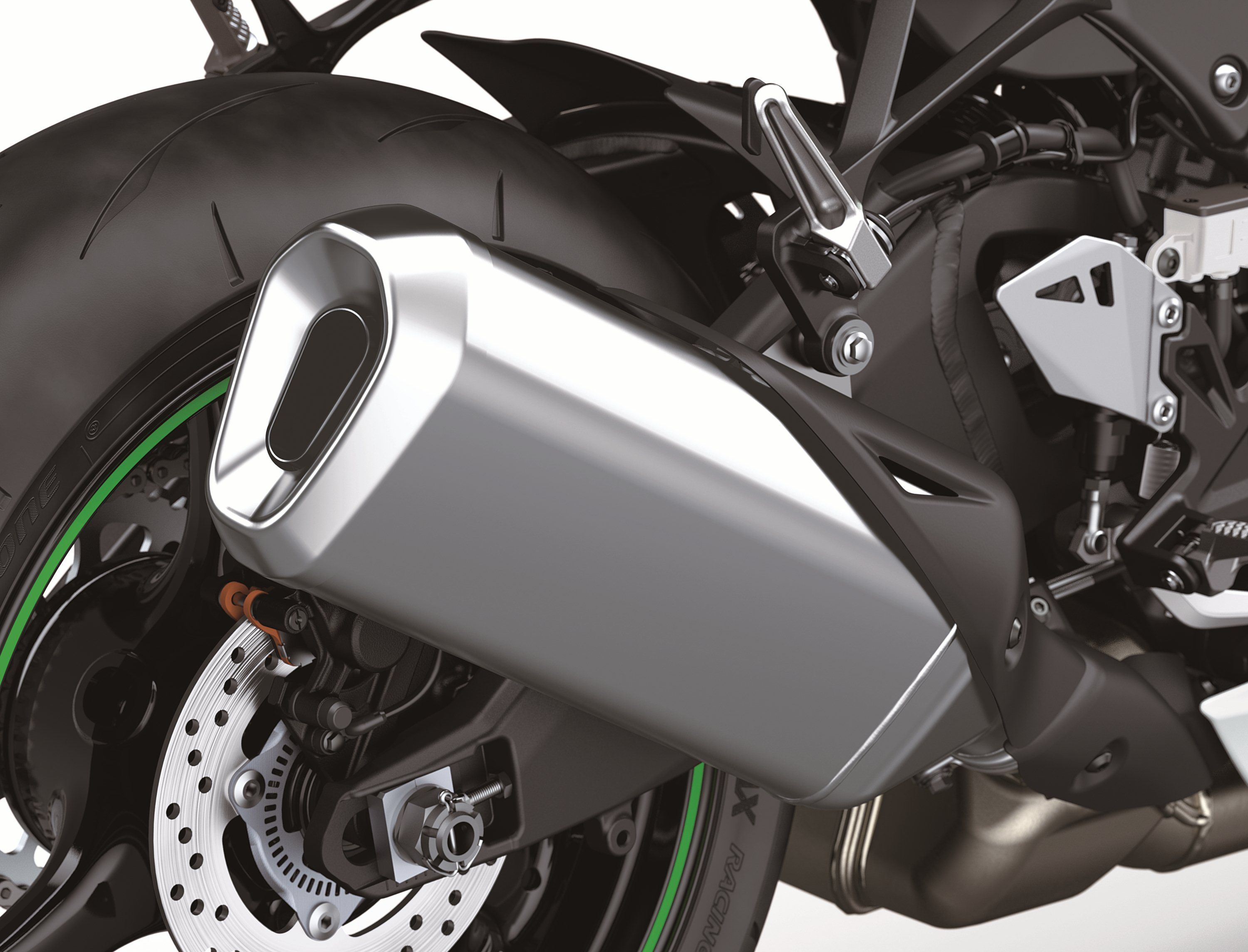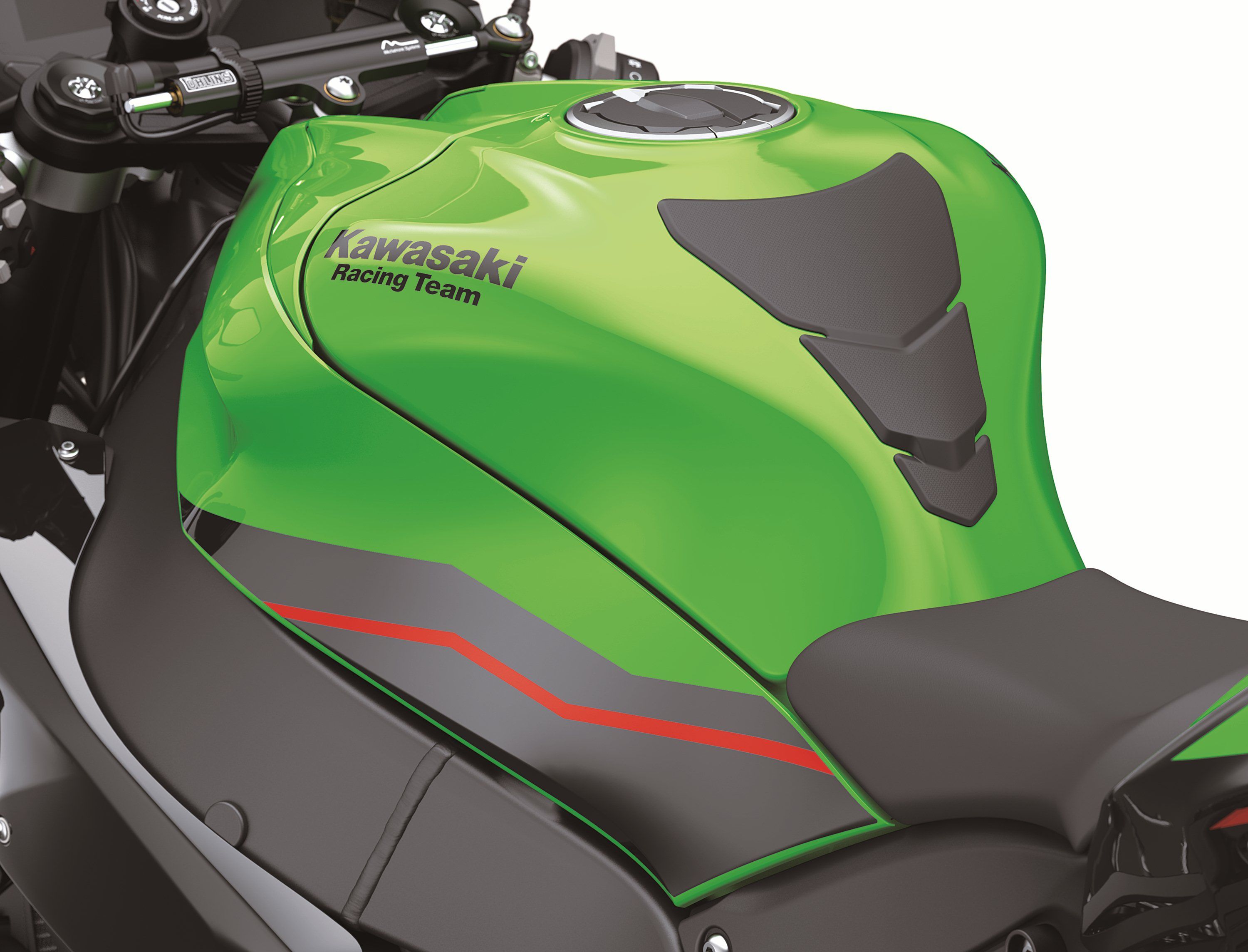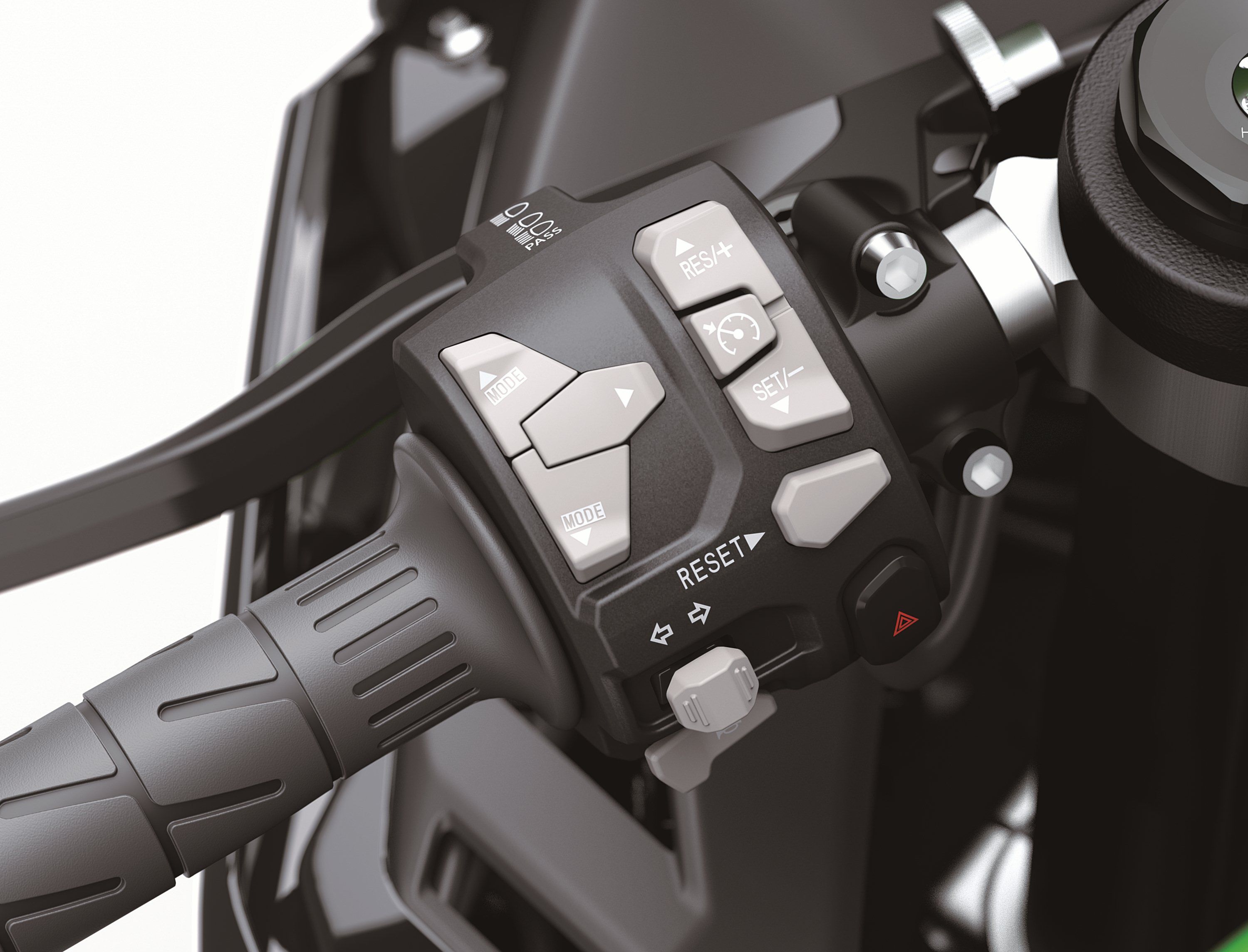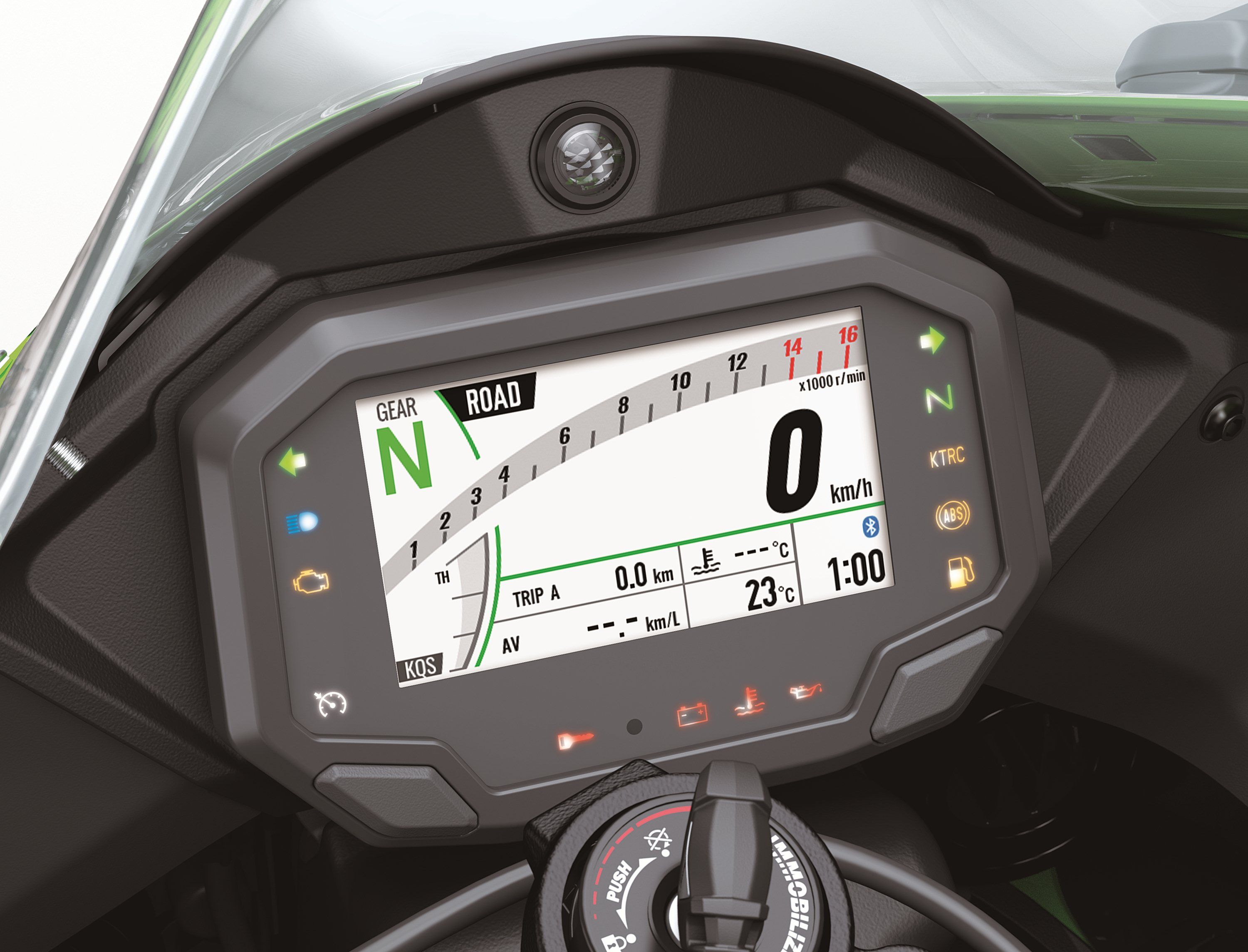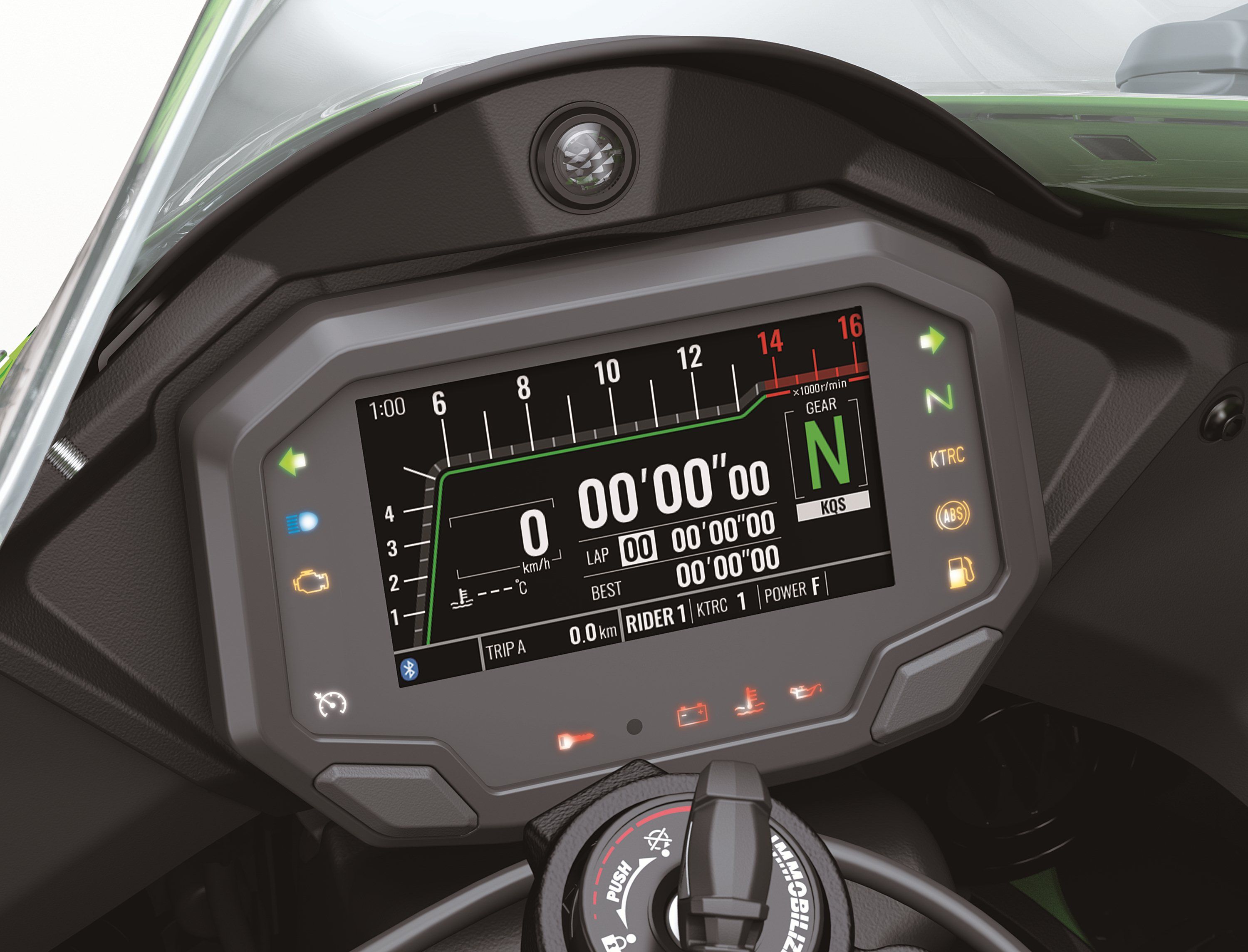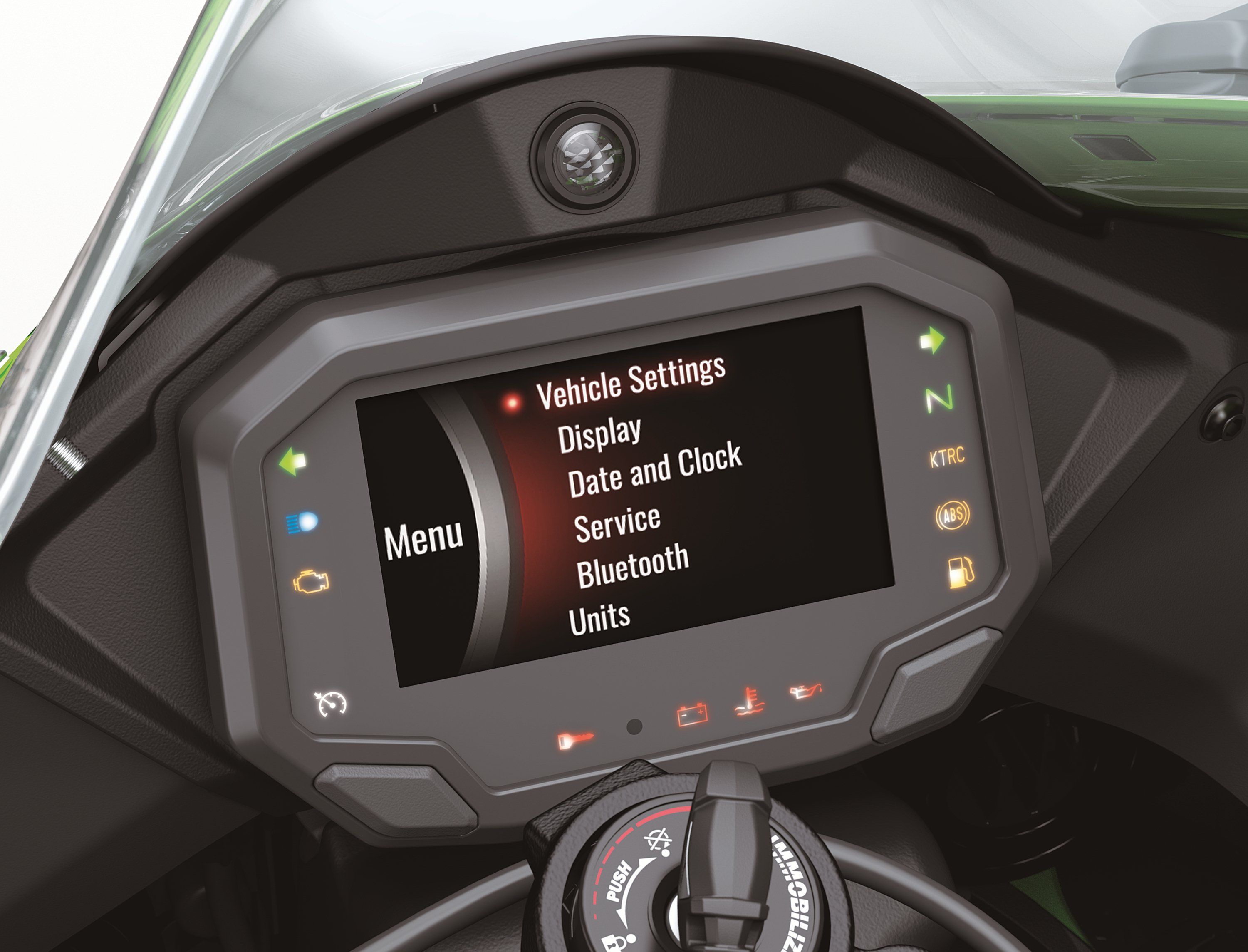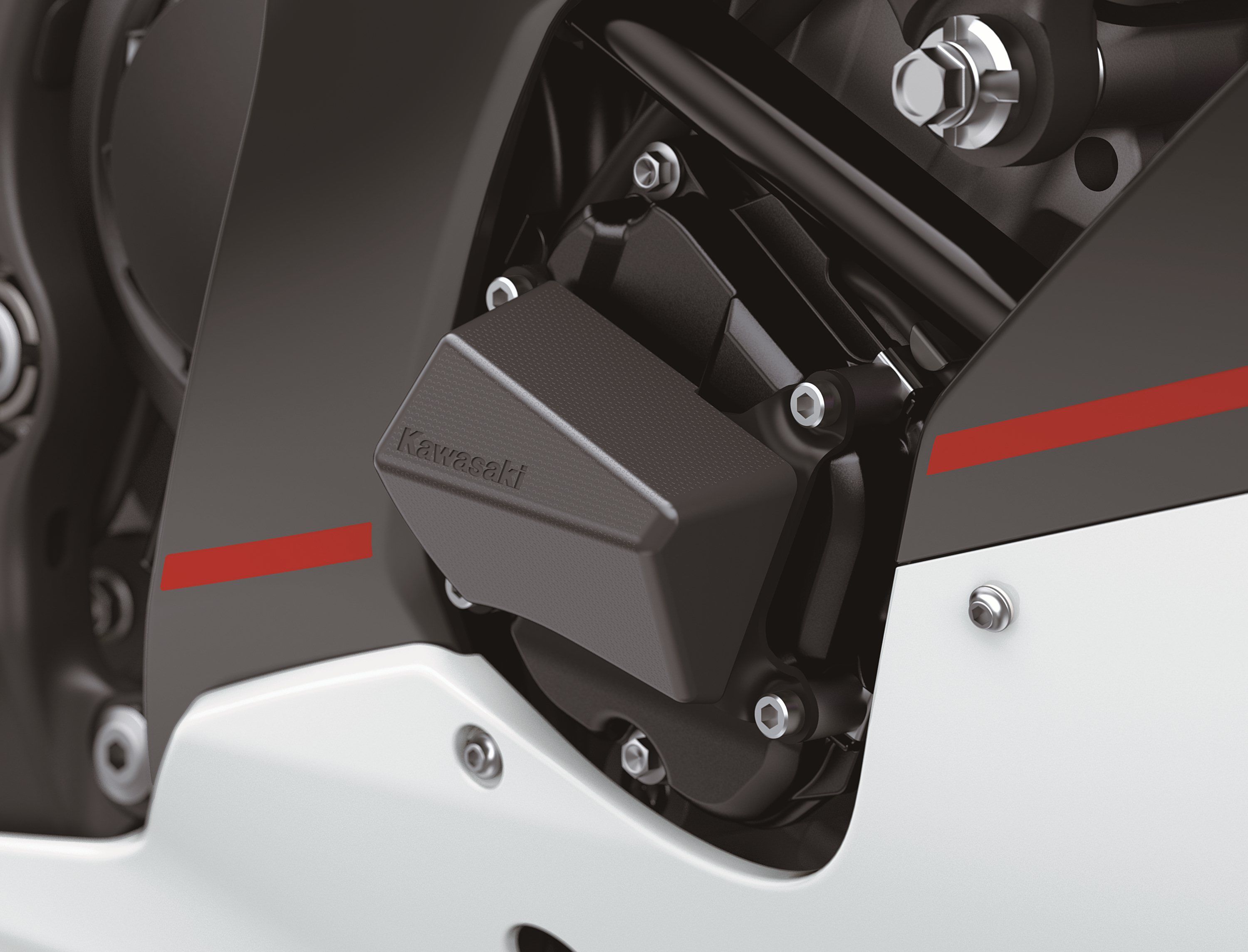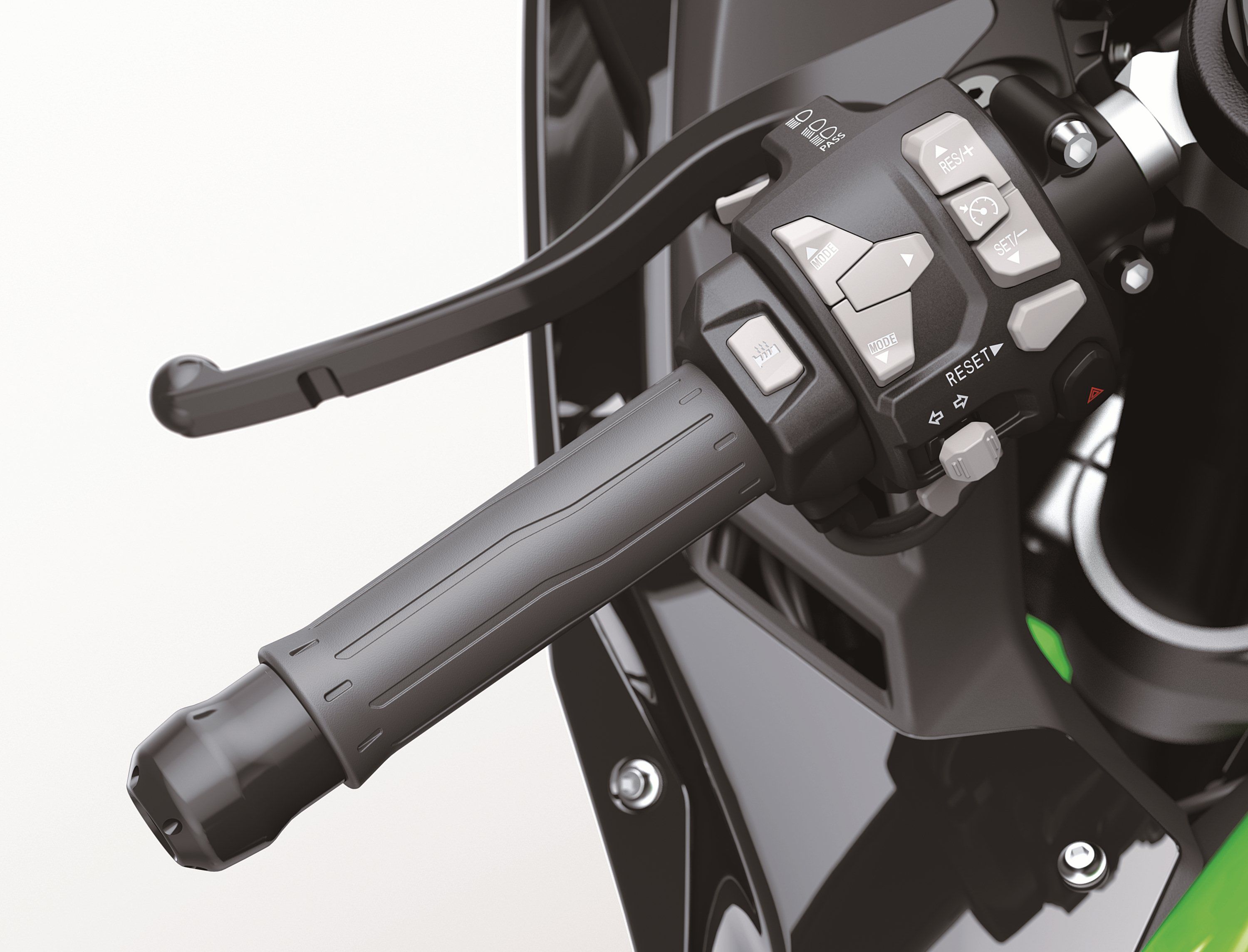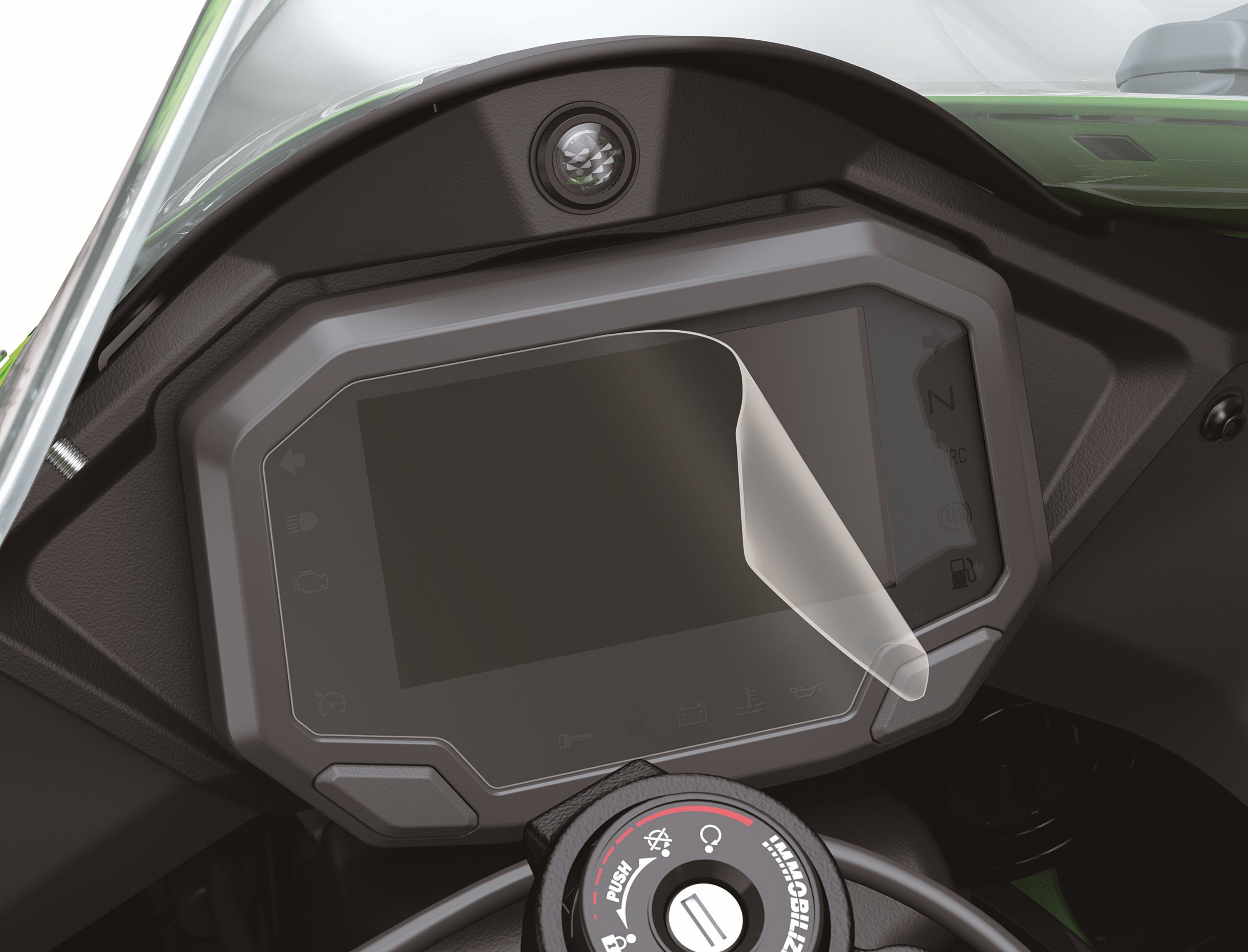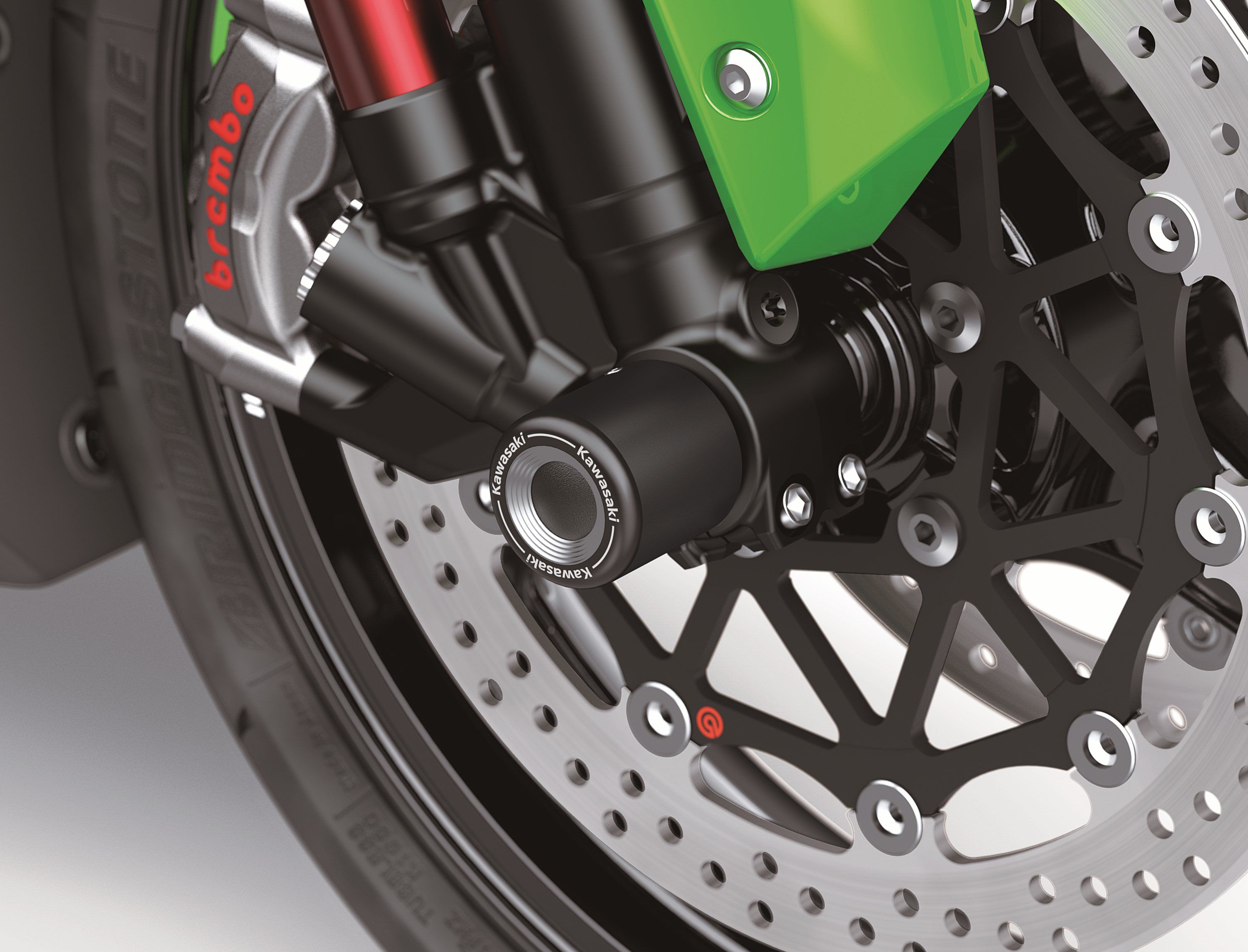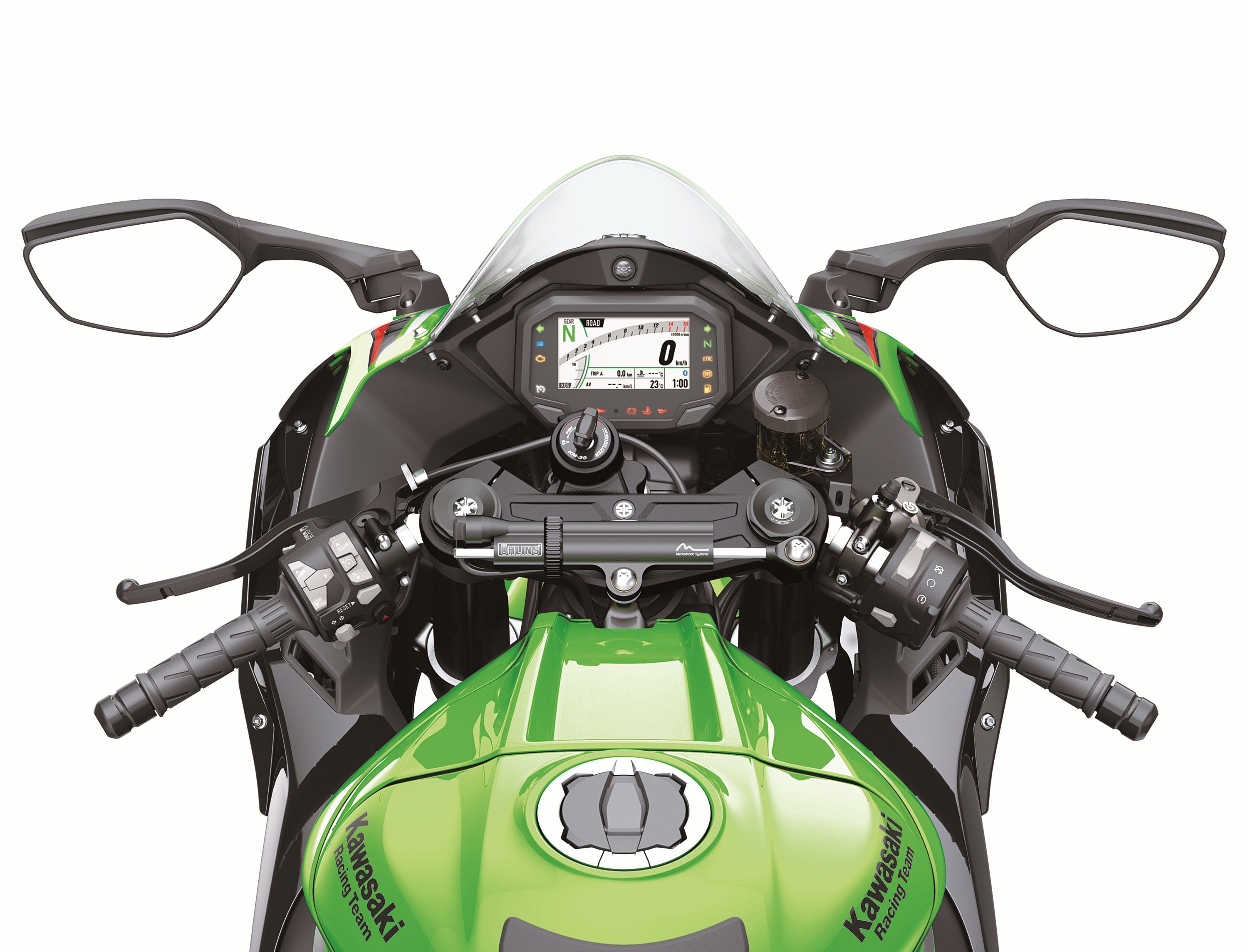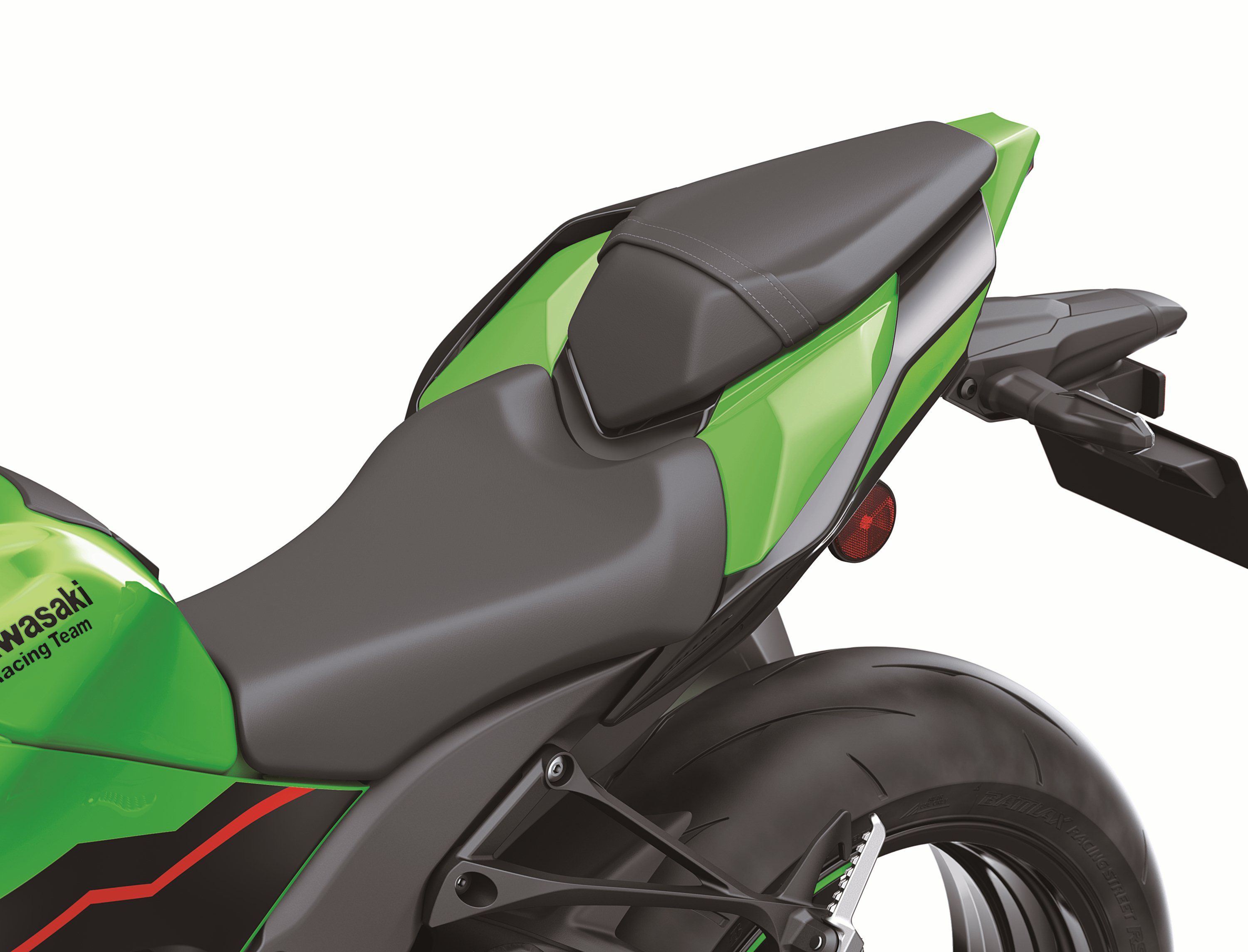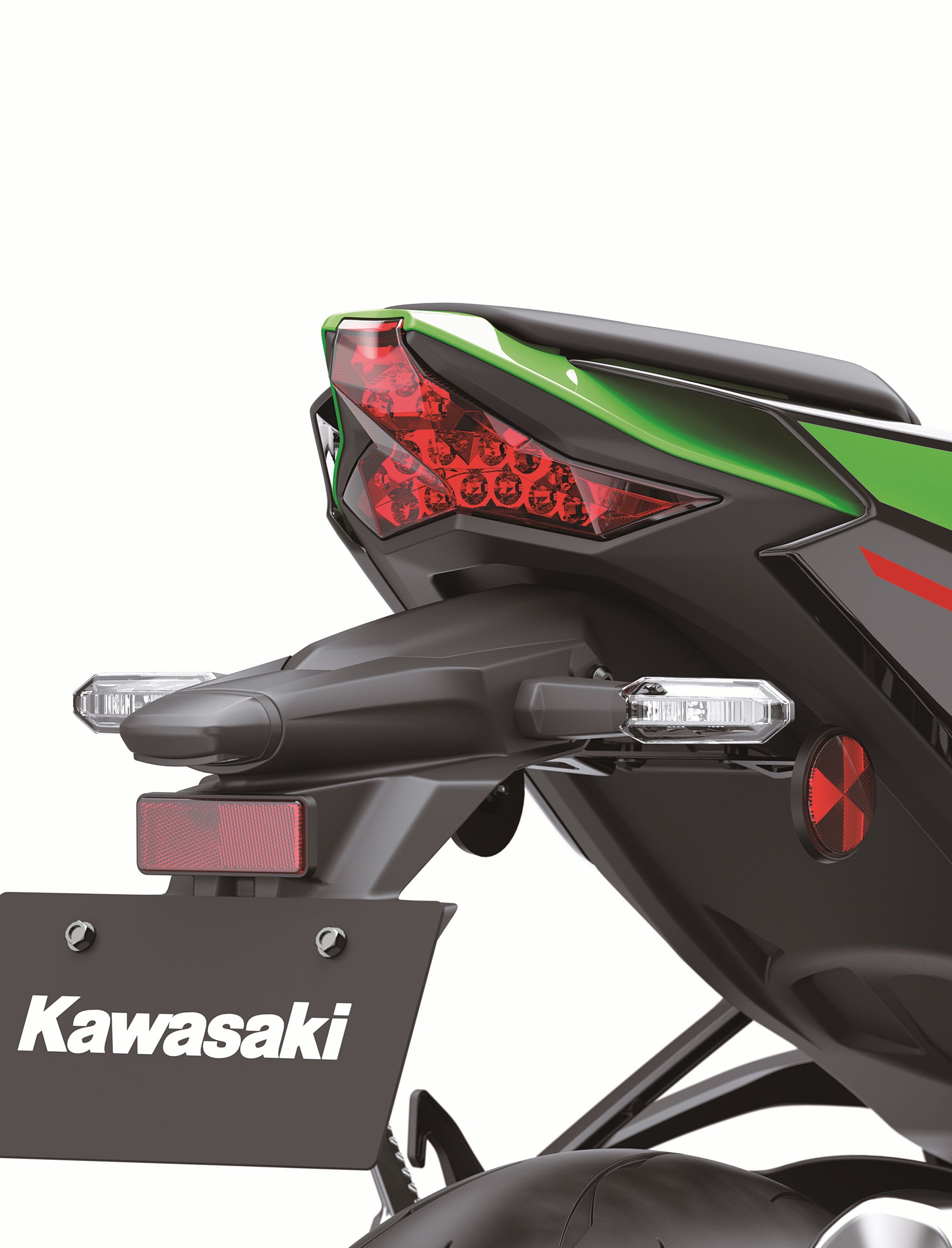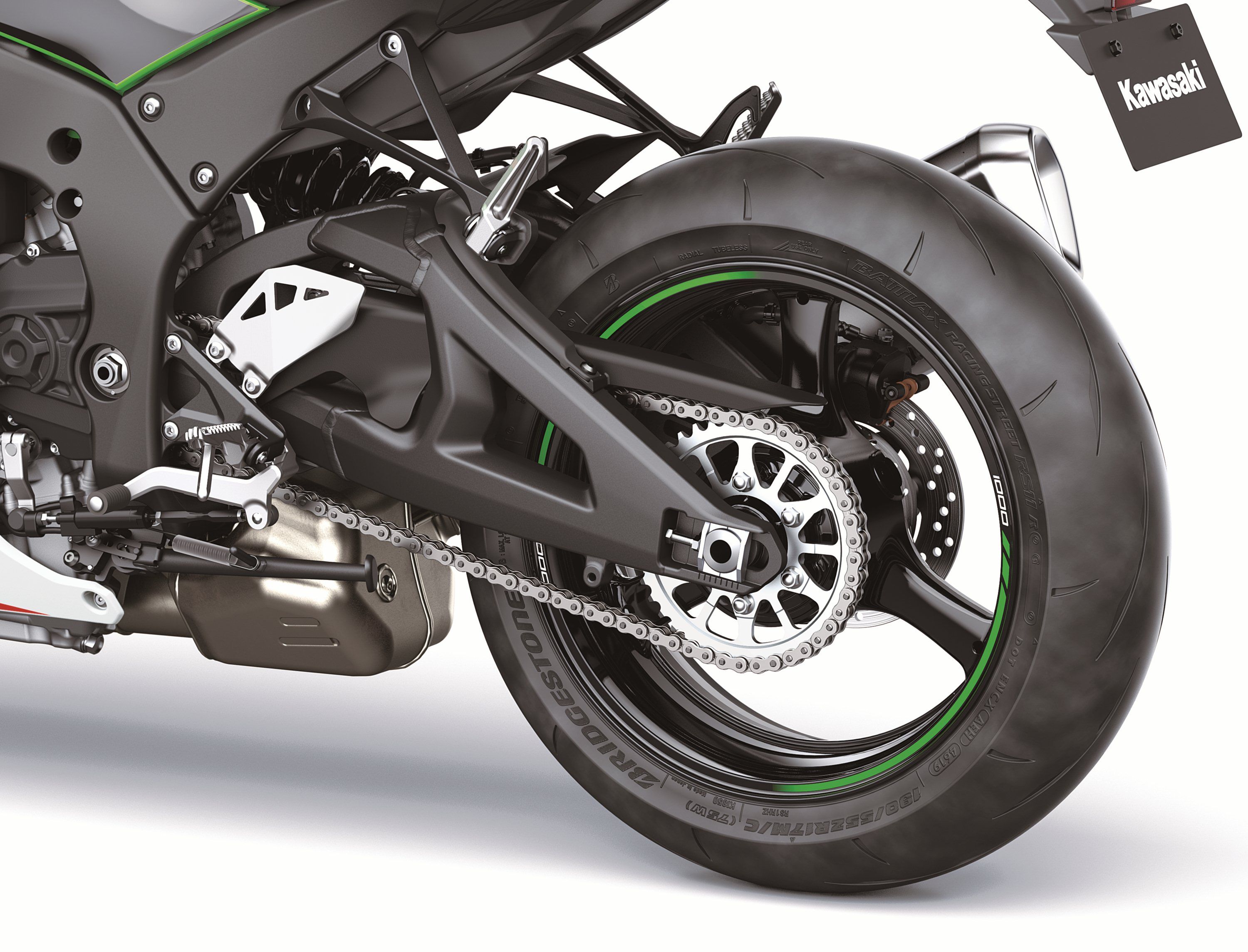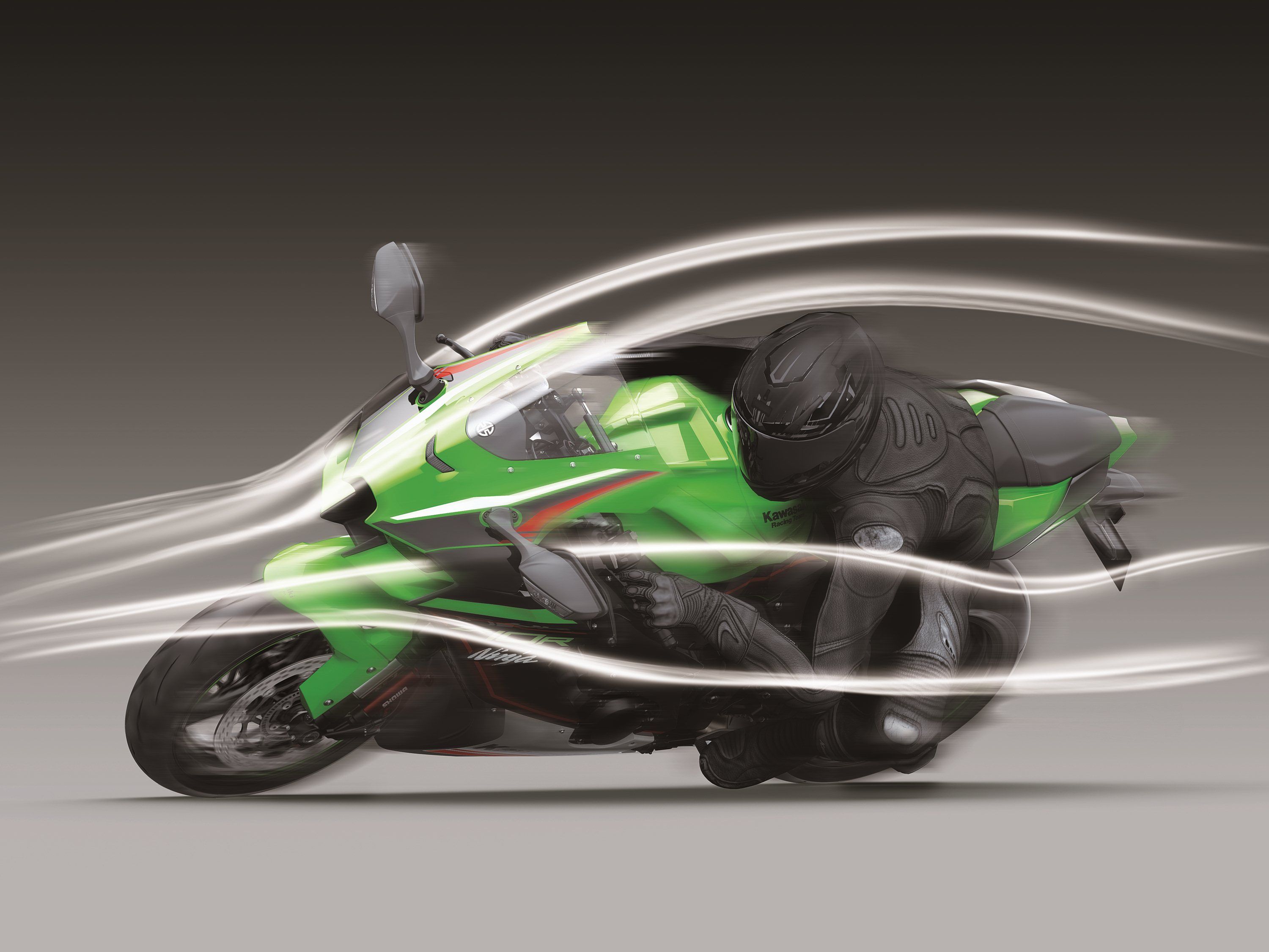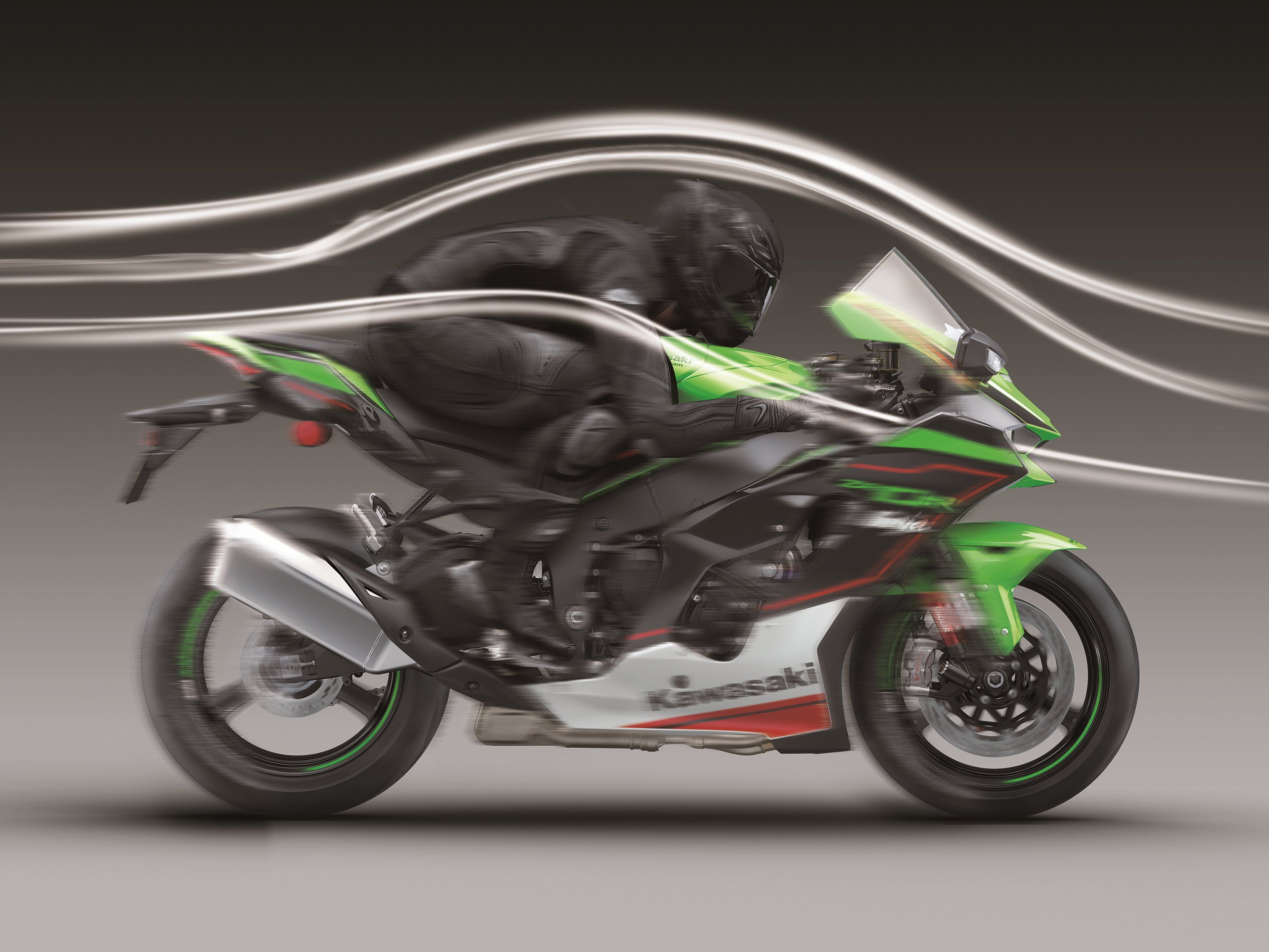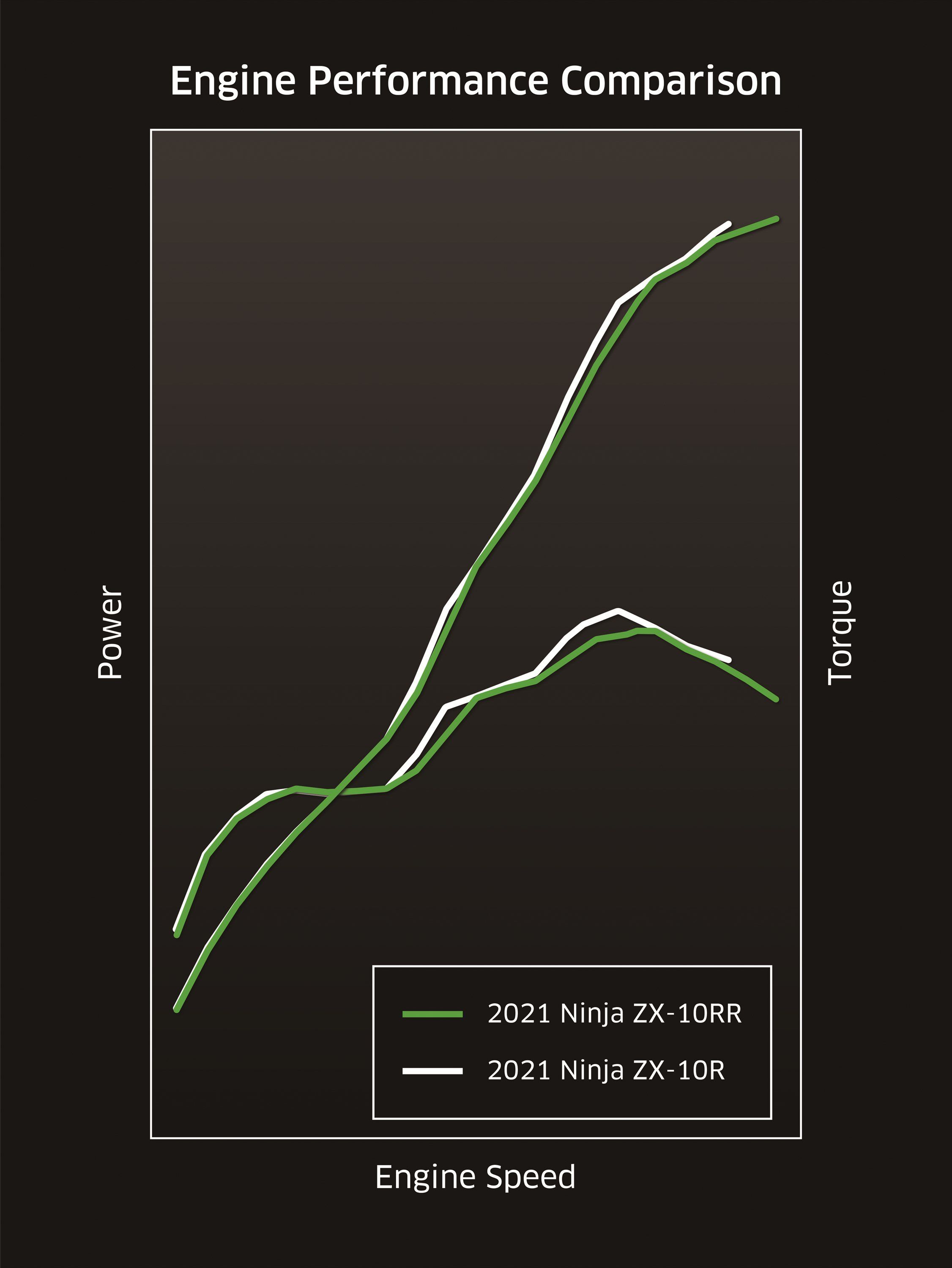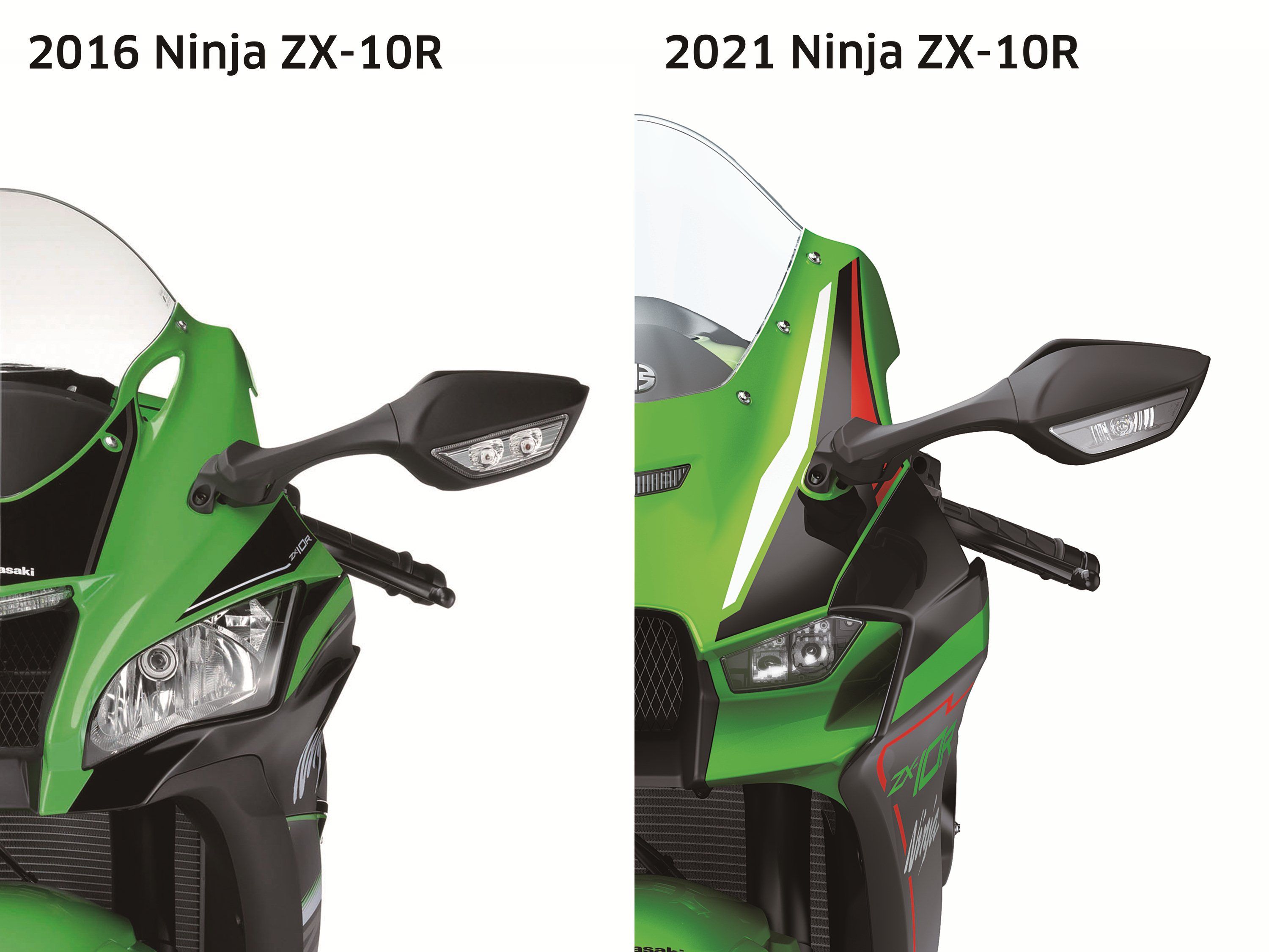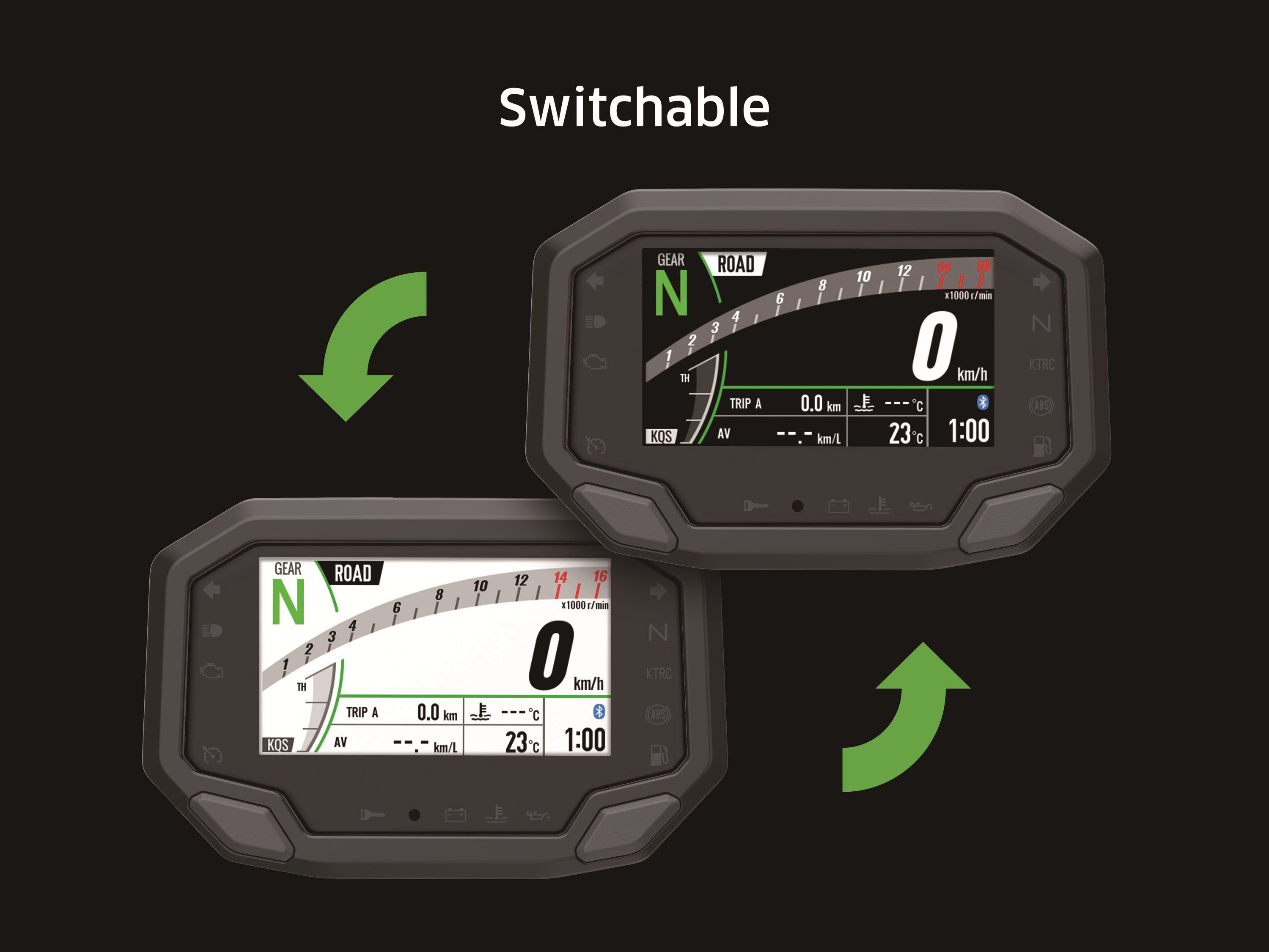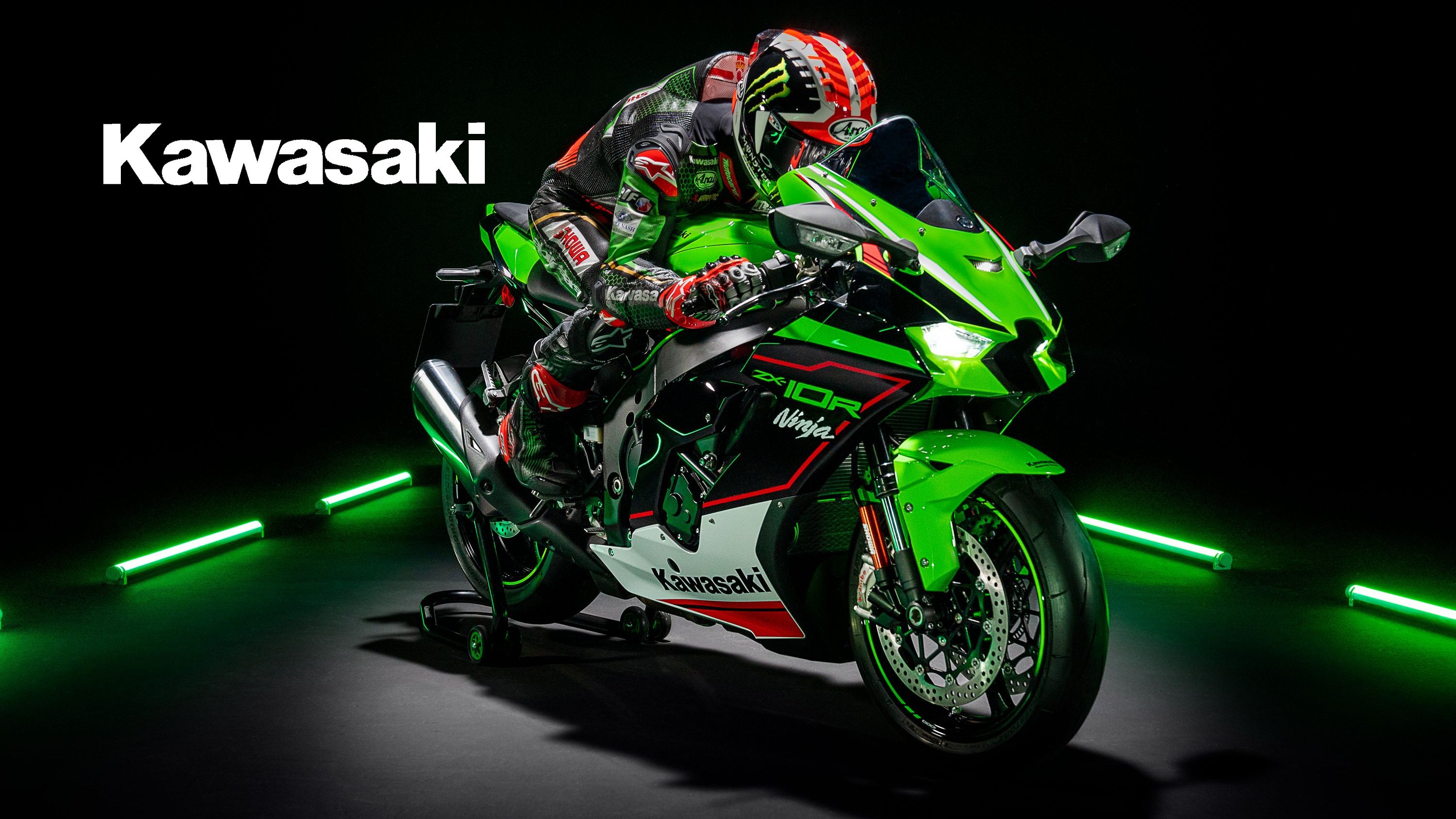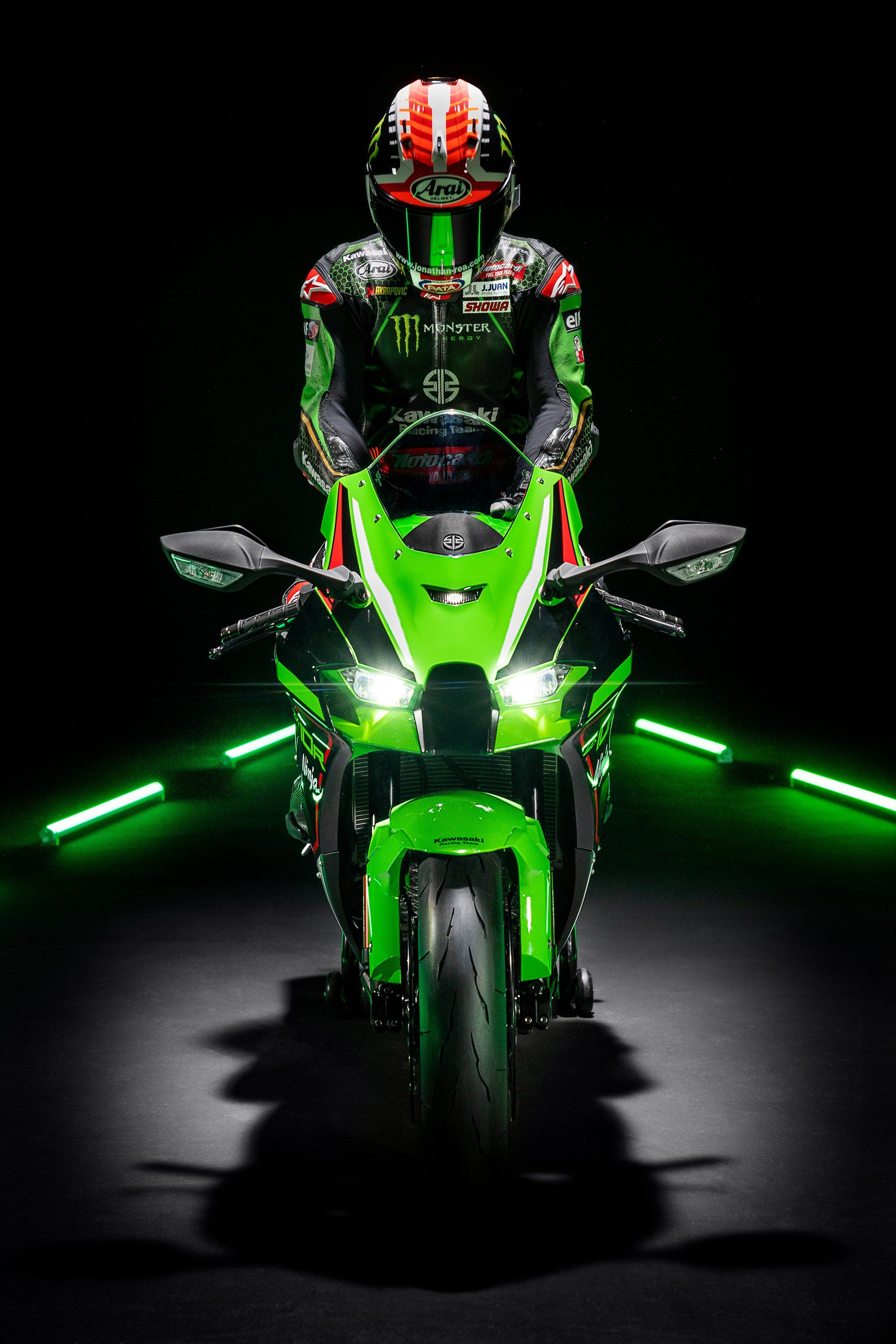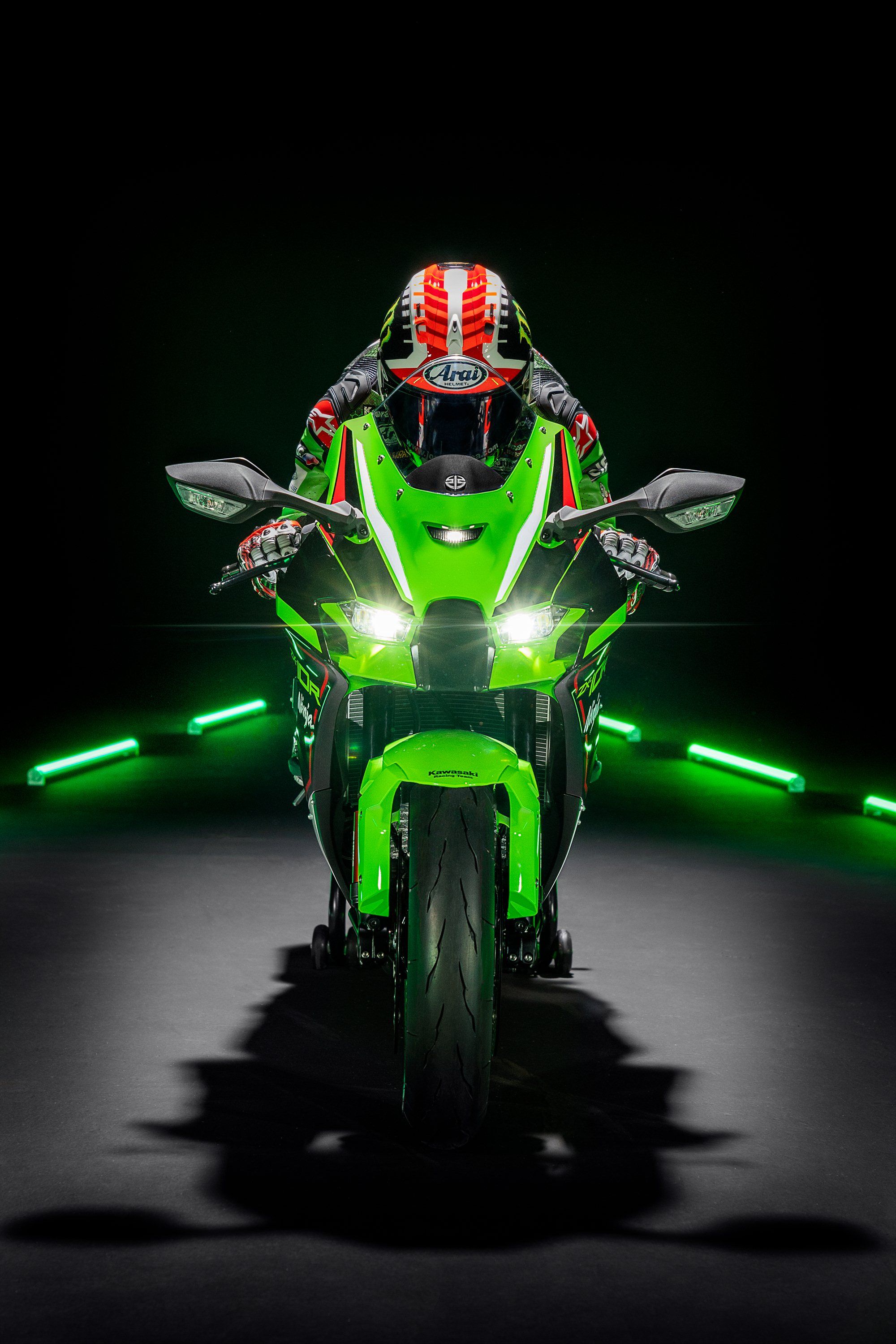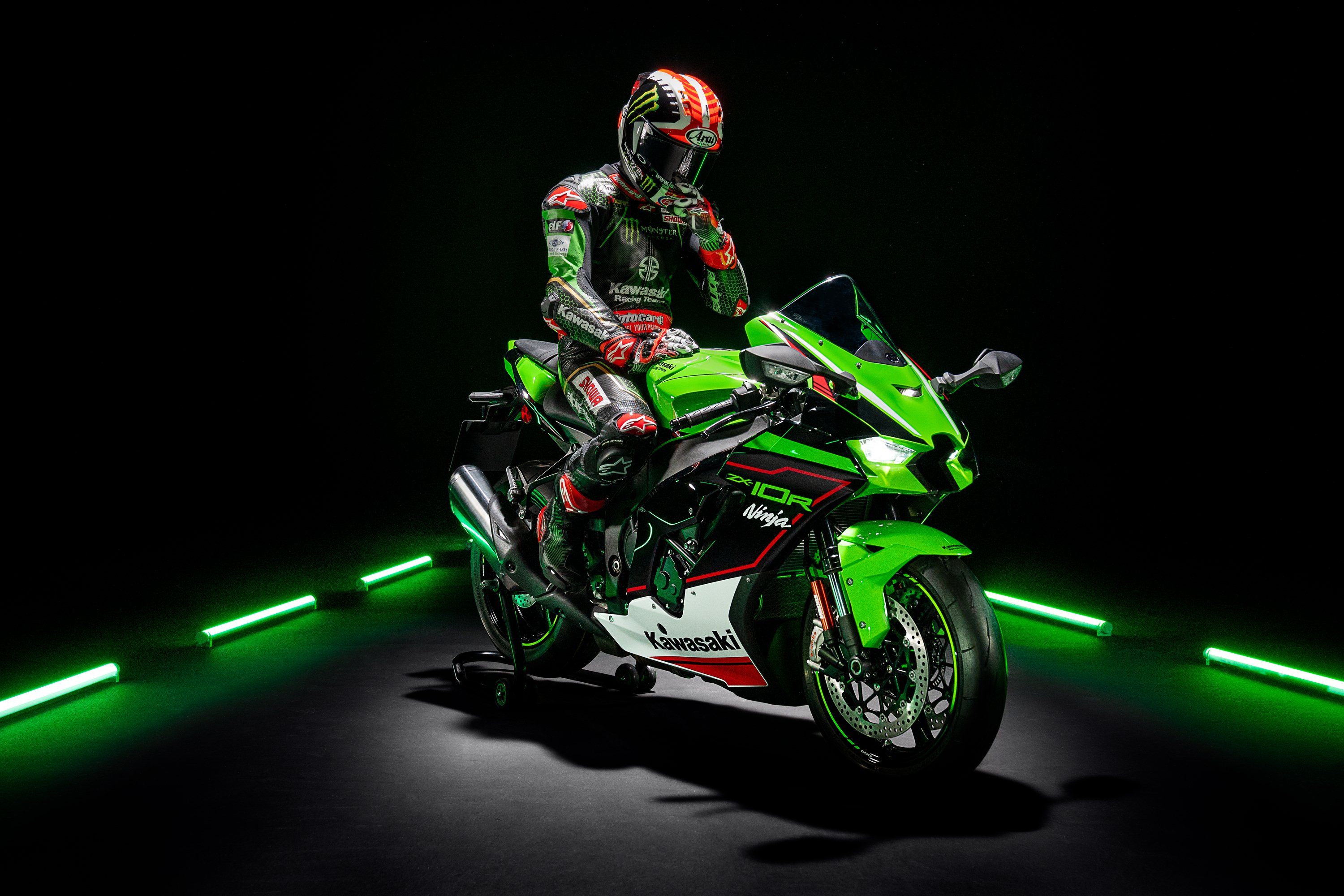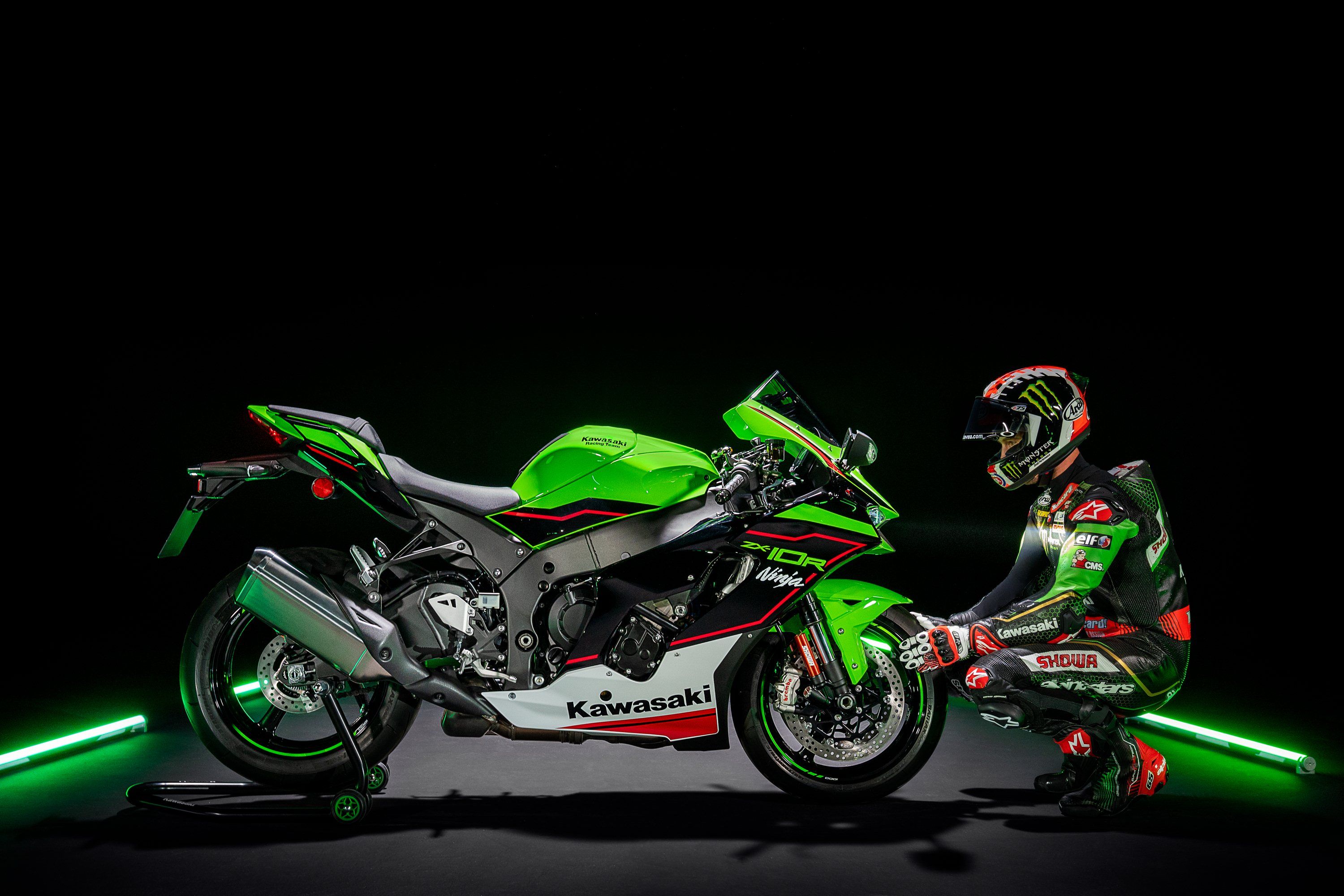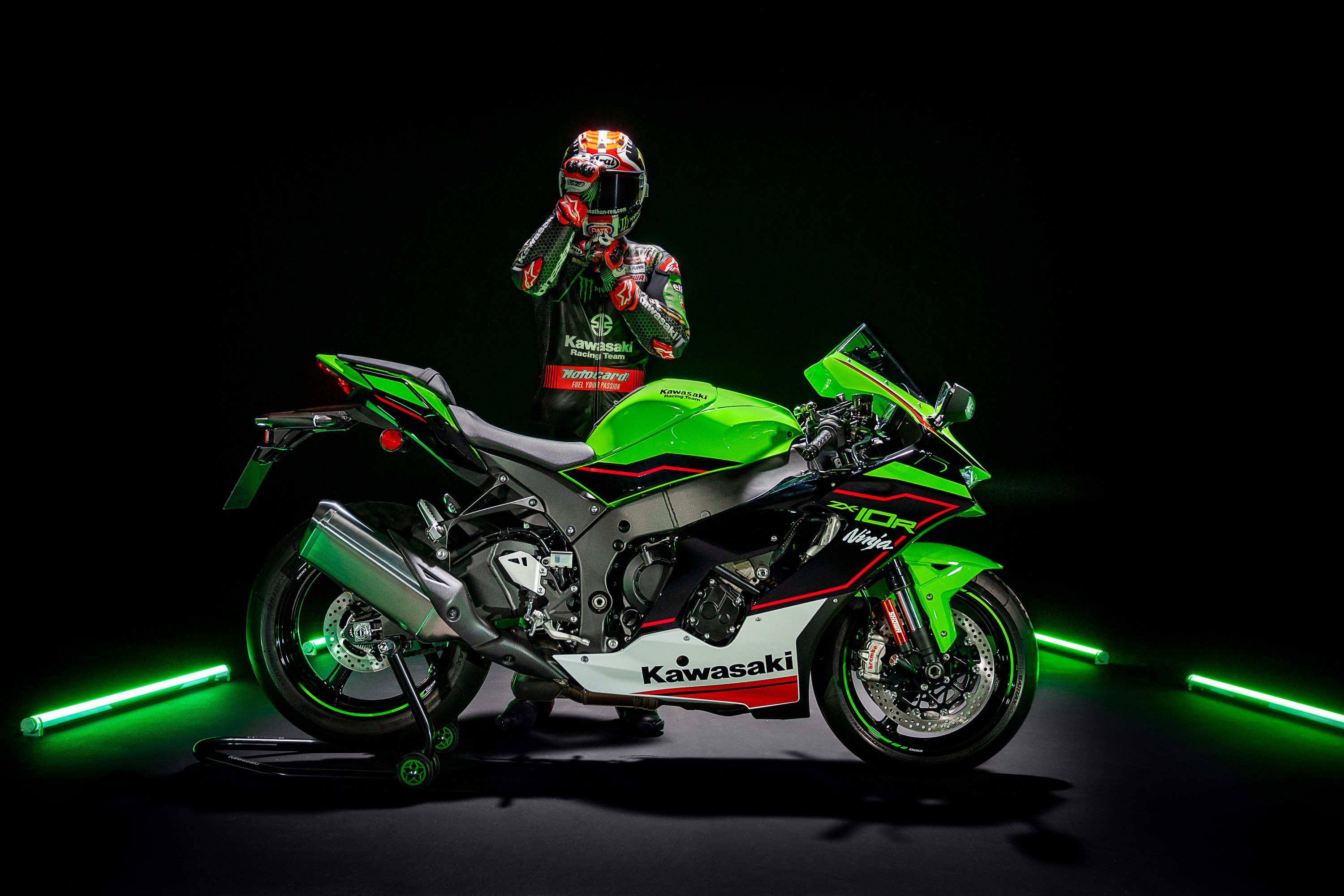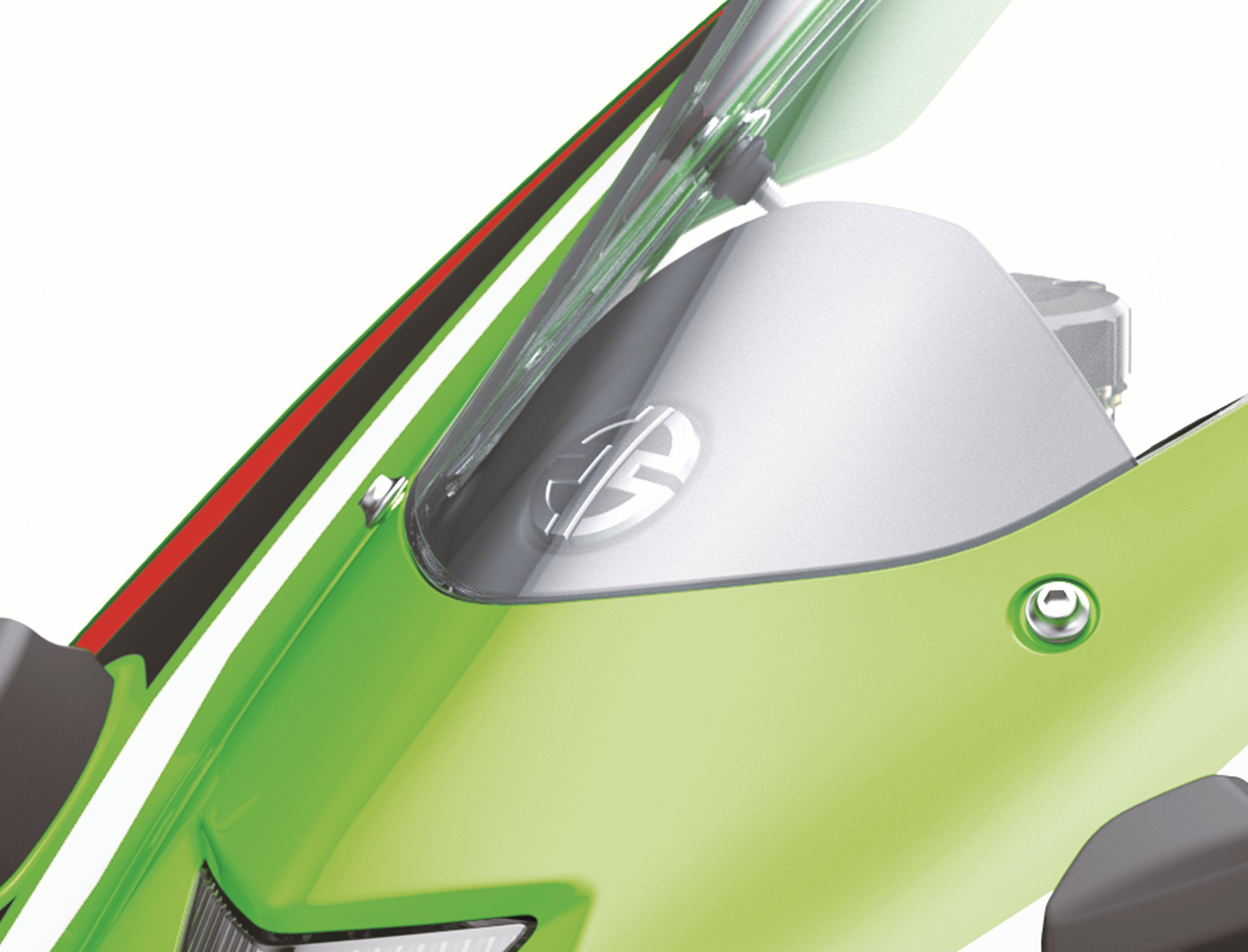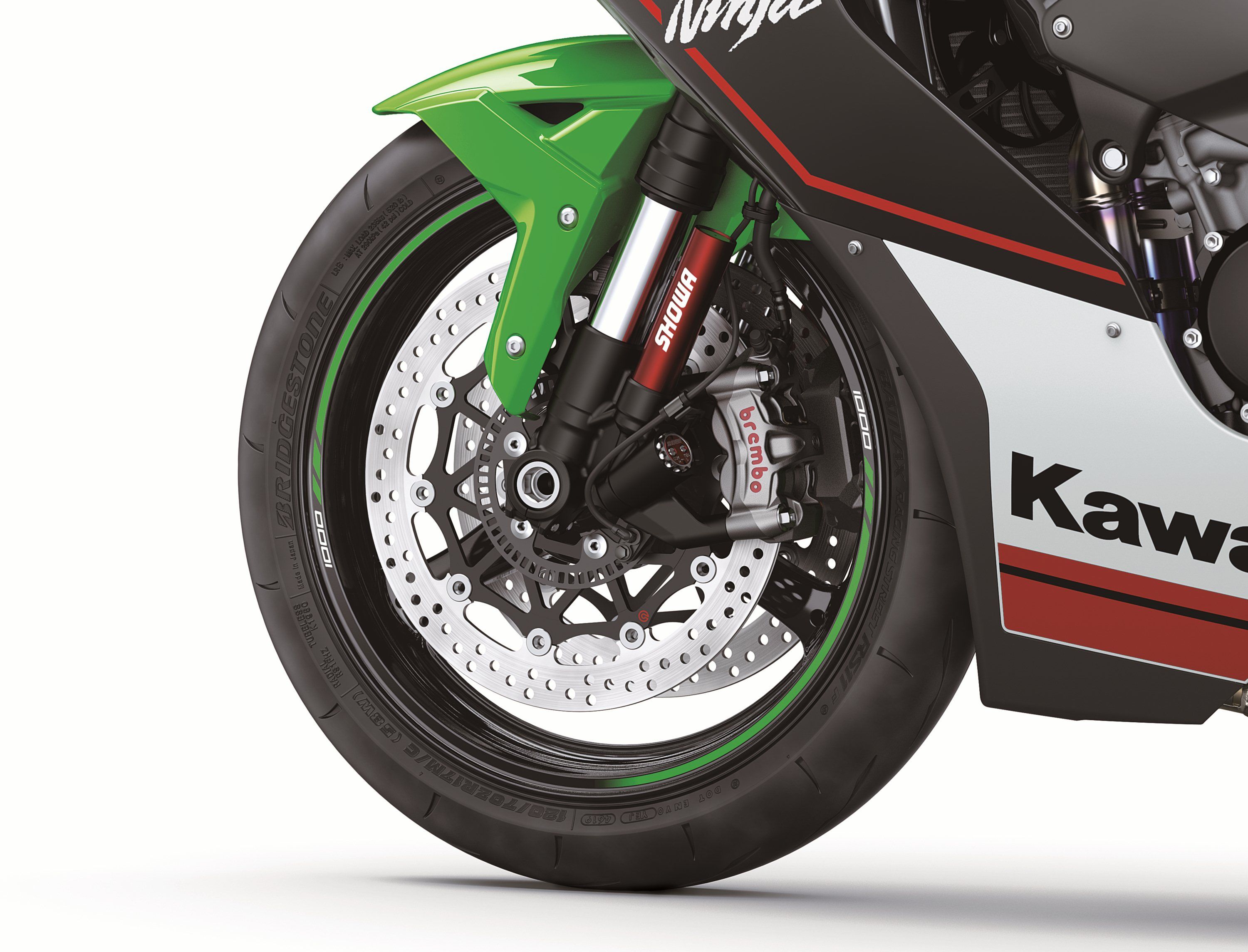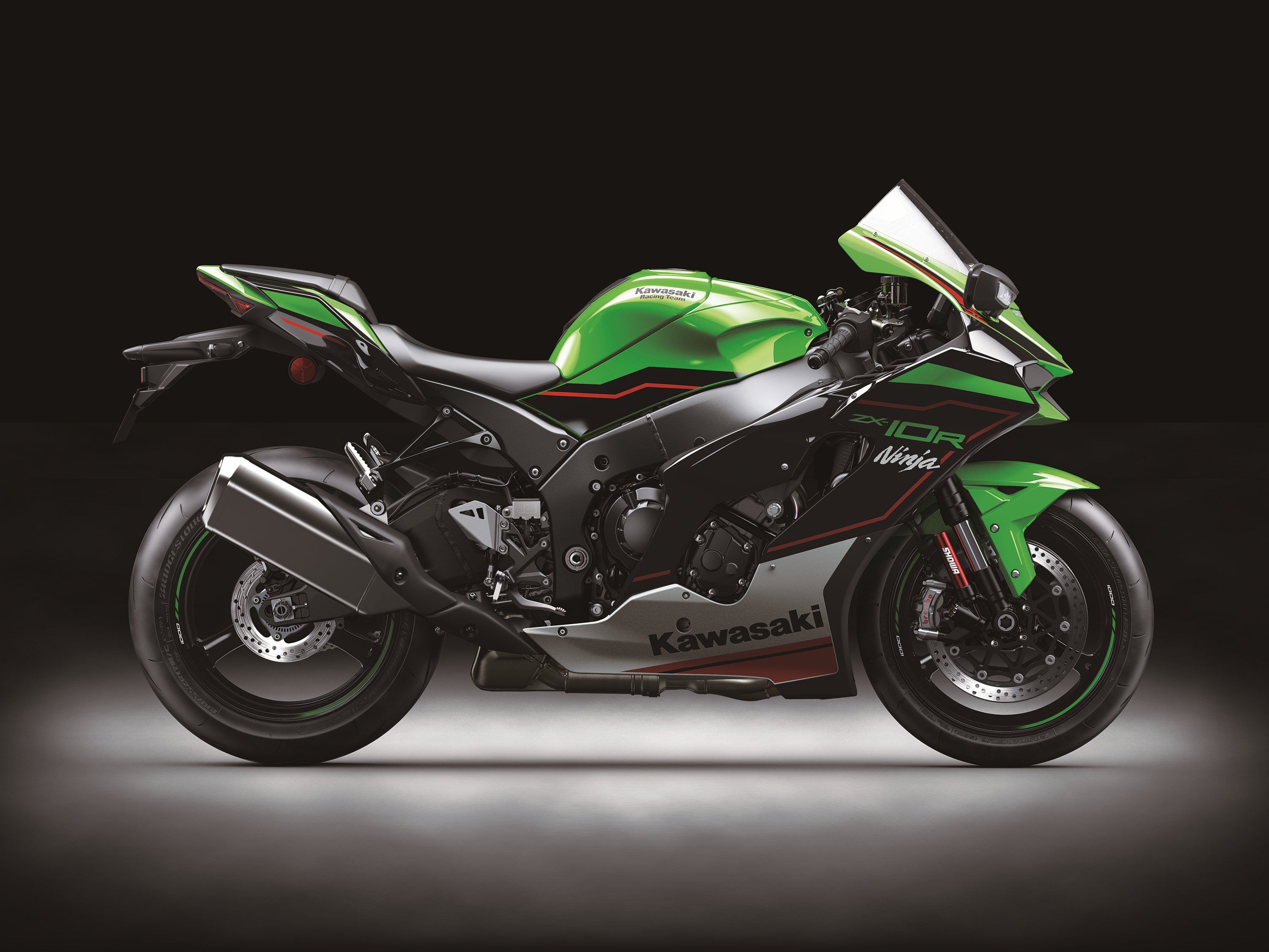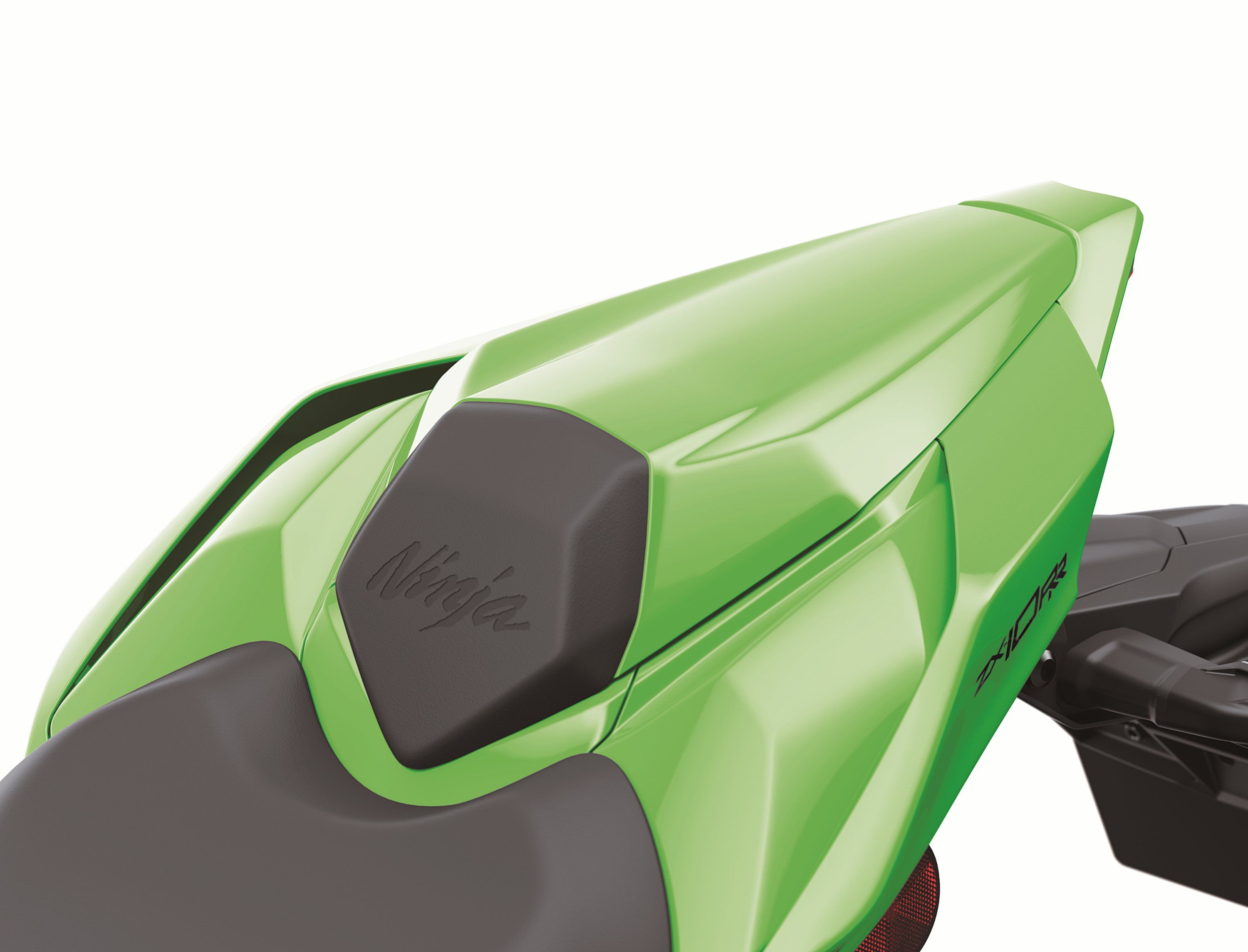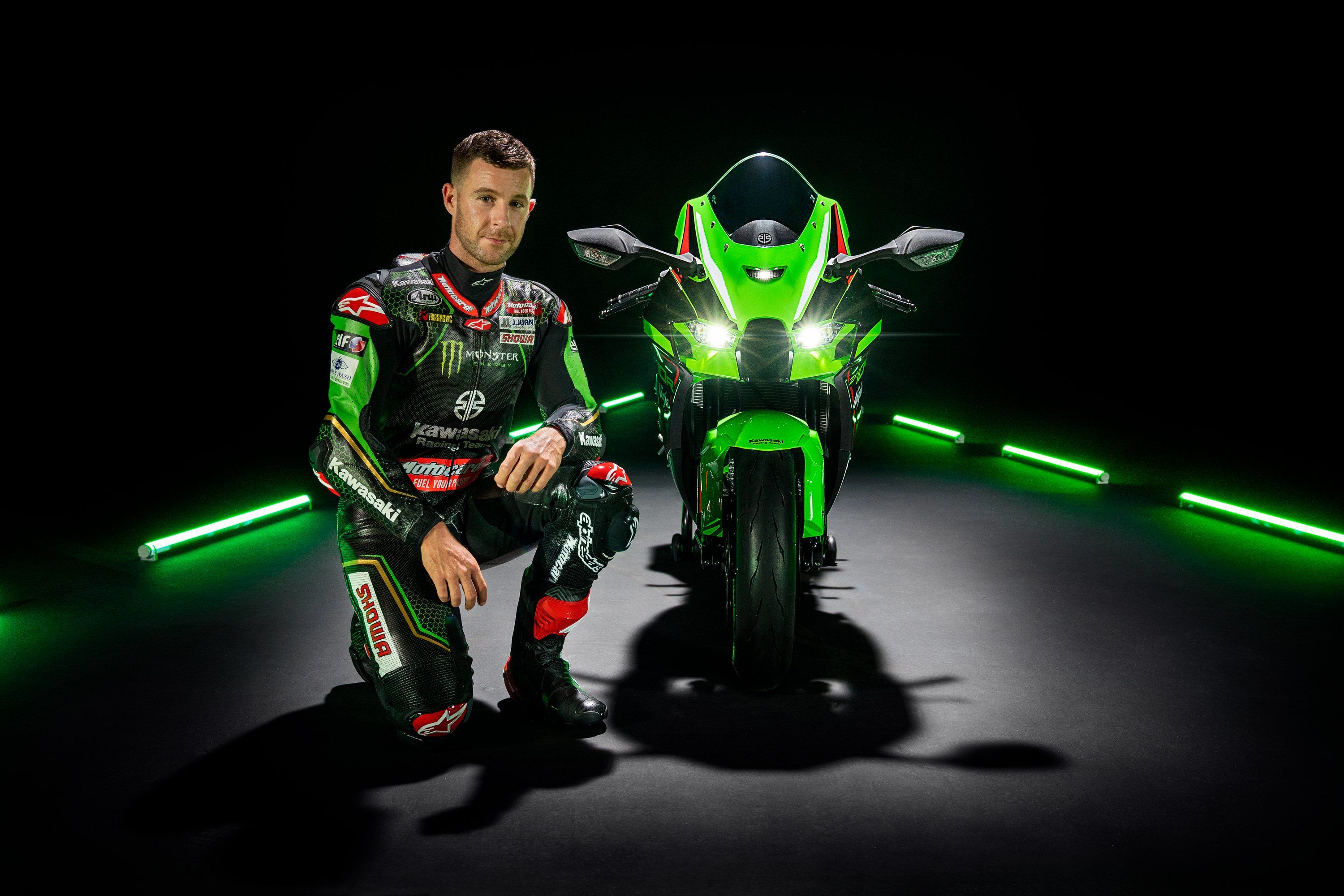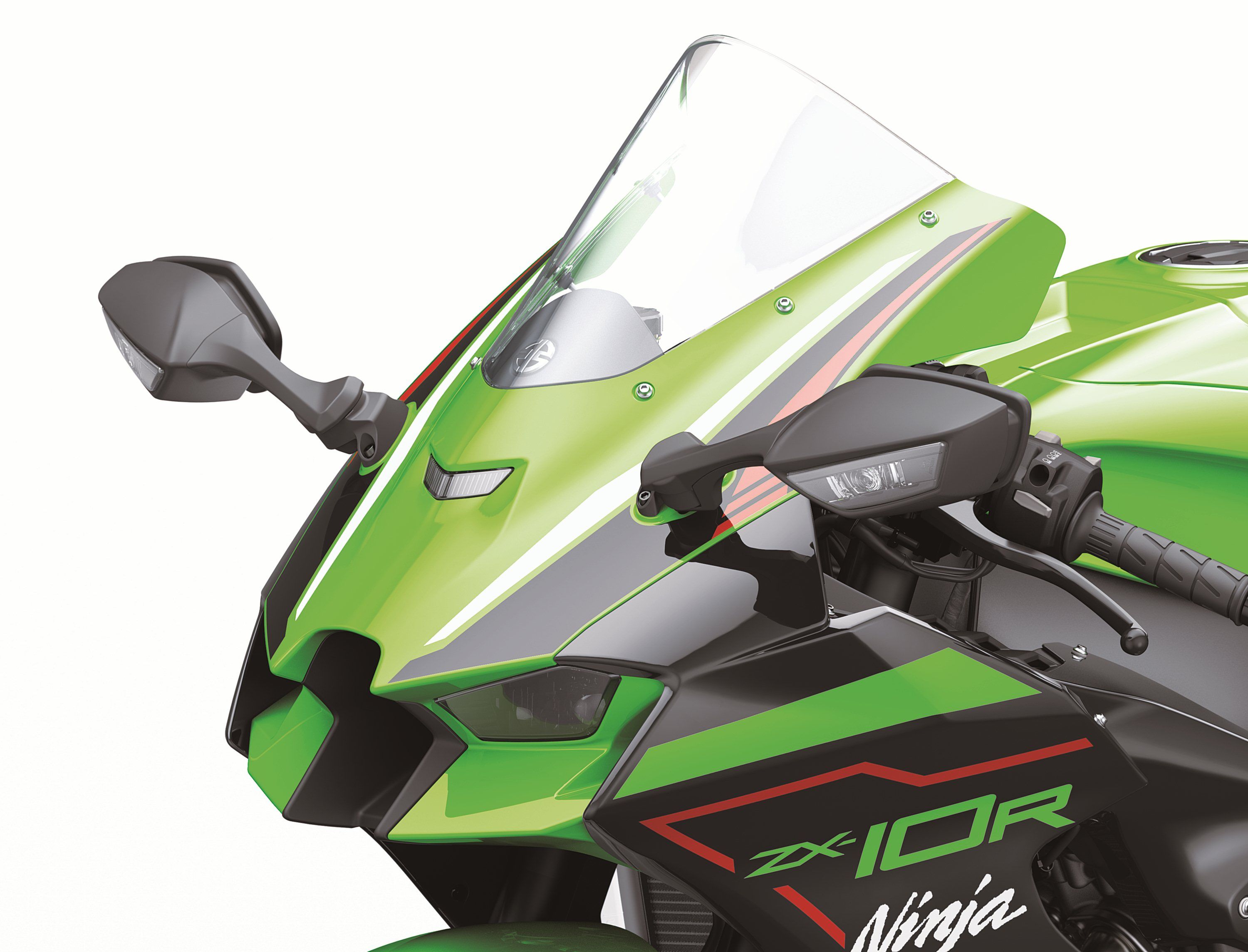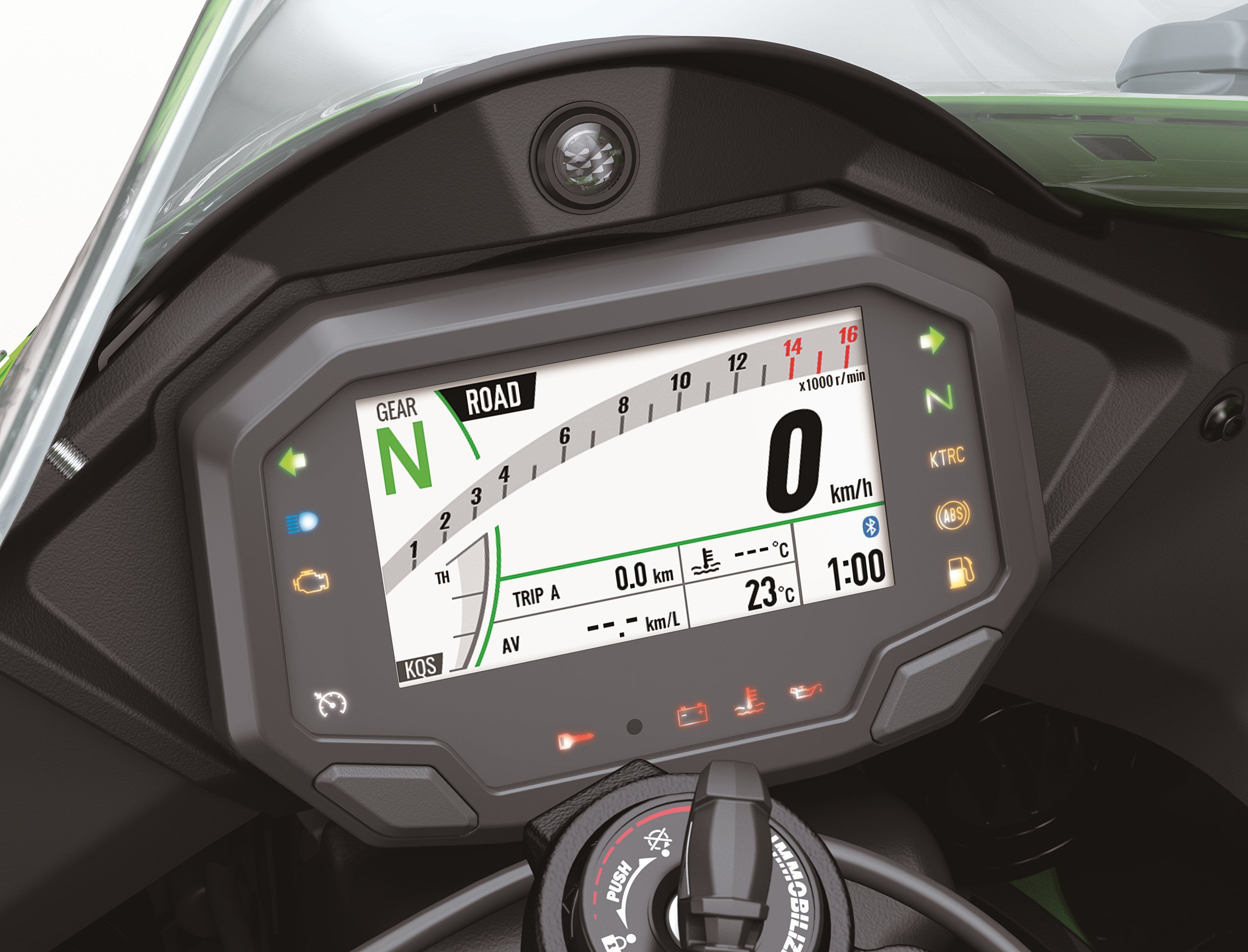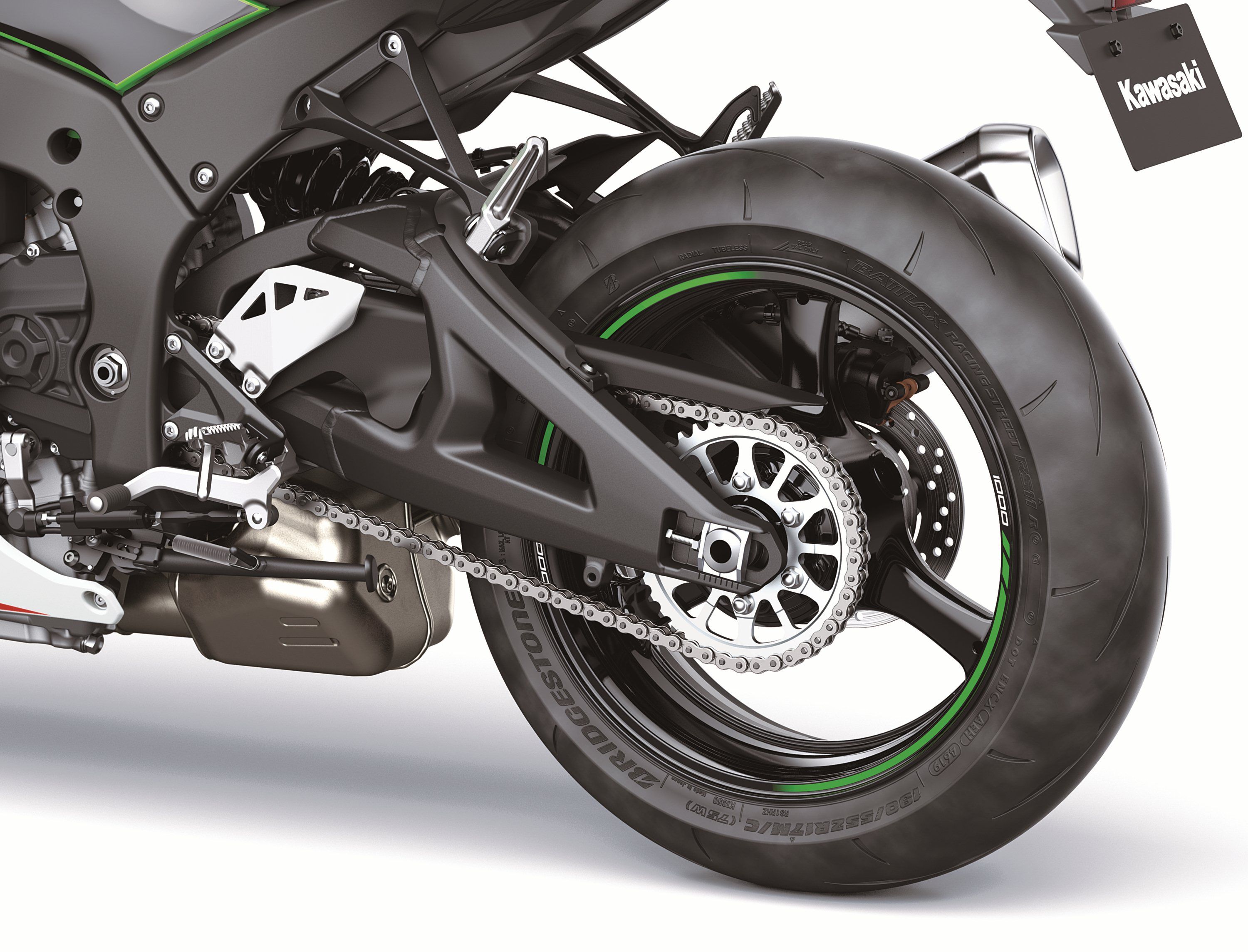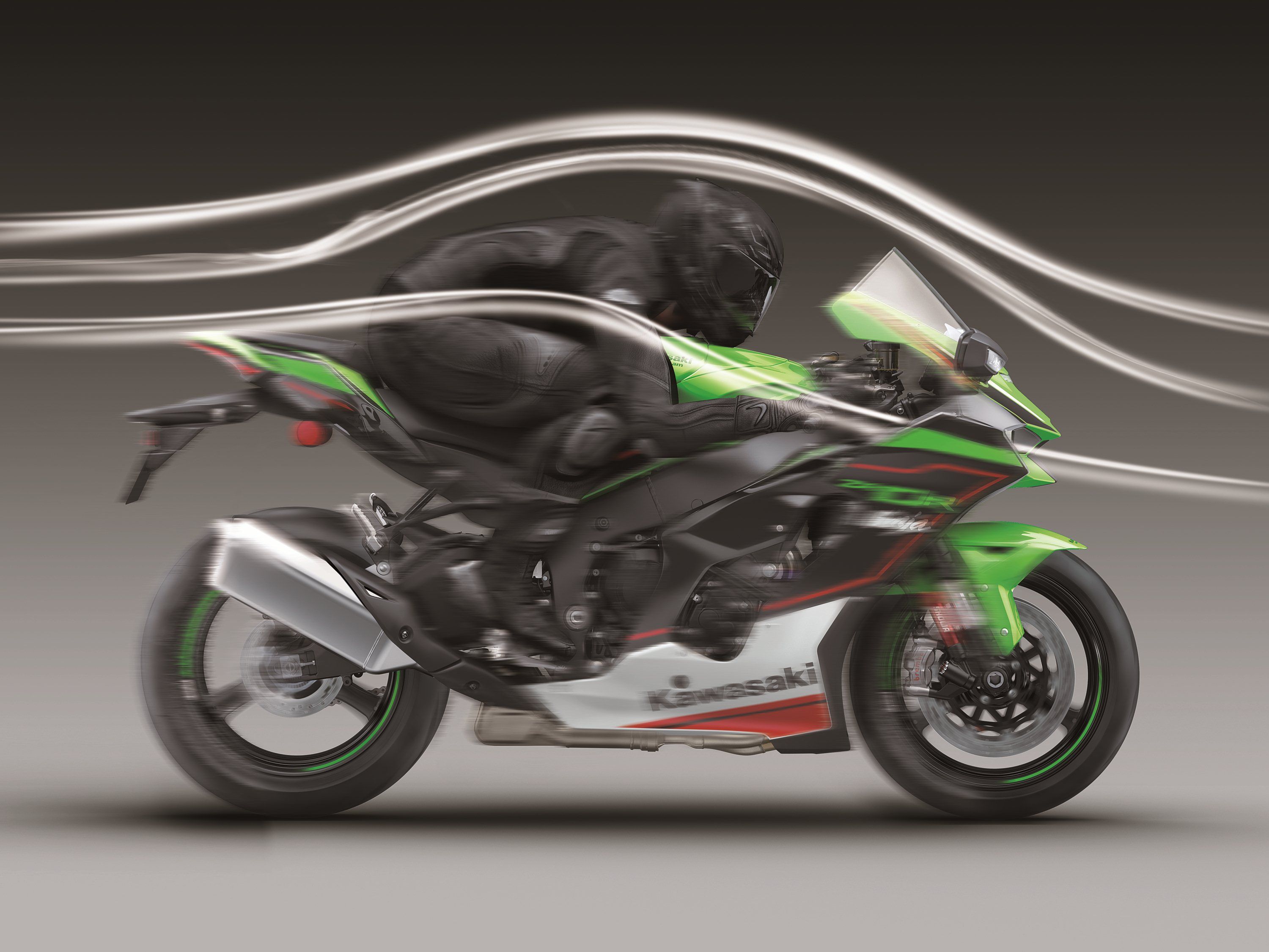Kawasaki takes its Superbike racing program to the bank with its made-for-public Ninja ZX-10R platform that brings an uncommon level of performance to the streets. A newly-updated engine carries improved cooling features and exhaust components with a new bundle of ride-control and ride-safety electronics to keep it all under control. Next-gen bodywork wraps up the package with windtunnel-tested efficiency and some interesting paint choices.
2021 - 2022 Kawasaki Ninja ZX-10R
- Make: Array
- Model: 2021 - 2022 Kawasaki Ninja ZX-10R
- Engine/Motor: inline-4
- [do not use] Vehicle Model: Array
Kawasaki Ninja ZX-10R Design
The front fender and fairing on the Ninja ZX-10R leads the way with recessed headlights that now come with LED projectors and next-gen styling, but it ain't all about the looks, not even close. New integrated winglets generate downforce at speed to help keep the nose down and spread out that front contact patch to get the most traction possible out of the front hoop.
An intake port between the flush-mount headlights takes advantage of the ram-air effect at the nose. It shunts that pressurized air directly into the intake tract which increases the volumetric efficiency of the engine, not entirely unlike a turbo or compressor, just with a more mild overall effect. To make it easy to set up for actual track use, the new LED front turn signals come integrated with the also-new mirrors to make it easy to strike both at once and subtract their heft from your race weight.
A newly-designed upper cowl and new taller bubblescreen help reduce drag even while they create a larger rider pocket than before. Vents in the side cowlings help purge waste heat and direct it away from the pilot's legs to improve comfort. The shape of the lower cowl is fairly typical with its dramatic scoop and all-up-front visual balance, but it too performs an important function as it forces cooling air across the oil cooler that adds another layer of protection for your engine by cooling its very lifeblood.
Behind the glass, a new, 4.3-inch all-digital instrument panel takes care of business with a color thin-film transistor screen that bundles the instrumentation and ride-control systems together in one spot. It now comes set up to network with your smartphone via Kawi's proprietary “Rideology The App” Kawi's proprietary “Rideology The App”}} to unlock the full weight of the infotainment system.
The 4.5-gallon fuel tank comes with a flat upper deck to accommodate an aggressive riding position. It comes with a precipitous drop to the tapered 32.9-inch saddle and has a strong wane toward the rear to mate up with the skinny midsection for a narrow waist that should help you reach the ground from the pilot's perch.
Out back, a pillion pad is joined by fold-up footpegs and a windtunnel-tested grabrail to complete the passenger's goodies, but to be frank, the back seat is barely wide enough to pad your passenger's nether regions, so it's in that “I'd rather not” category.
The LED taillight rides recessed in the tip of the stinger while a bolt-on mudguard supports the rear blinkers and license-plate holder for easy removal ahead of race days.
Kawasaki Ninja ZX-10R Chassis
Even the bones of the Ninja ZX-10R saw some performance tweaks. The aluminum twin-spar frame takes a direct path from the steering head to the swingarm pivot for strength and rigidity. A new longer wheelbase and swingarm pivot point that was lowered by 1 mm deliver increased control in the corners while the swingarm itself was stretched by 8 mm as well for better composure. The above features help move the balance point forward just a bit and reduce the trail to 4.1 inches for eager reversals and quick flicks in the bends. A newly lowered tripleclamp and its 25-degree rake angle factors in at the agile end of the spectrum as well to wrap up the steering geometry.
Showa provides the suspension equipment with a set of usd, Balance Free Front Forks bring even more SuperBike prowess to the table with revised upper stanchions for the extra strength they impart to the structure. New track-focused compression- and rebound-damping joins a lower spring rate for lighter handling characteristics in the front end.
Out back, Showa's Balance Free Rear Cushion shock takes care of business with adjustable compression- and rebound-damping features, and like the front end, it benefits from Kawi's SBK experience to bring a rare level of track readiness to the streets. The full trinity of adjustments are available up front, but the rear adds both high- and low-speed compression-damping adjustments to the mix with 4.7 inches of travel at the front axle and 4.5 inches at the rear.
Cast-alloy rims roll in a three-spoke design and come lined with Z-rated rubber in a 120/70 ahead of a 190/55 to make the connection to the tarmac. You can choose between a KIBS-equipped ABS-only model, or go raw on the brakes with the non-ABS variant. Brembo supplies the anchors with four-piston, radial-mount calipers that bite dual 330 mm discs to haul the front wheel down. Out back, a single-bore caliper clamps a 220 mm rear disc, and both ends benefit from new brake pads that deliver finer control and stronger braking effort.
|
Frame: |
Aluminum perimeter |
|
Front Suspension / Wheel Travel: |
43 mm inverted Balance Free Fork, adjustable stepless rebound and compression damping, spring preload adjustability/4.7 in |
|
Rear Suspension / Wheel Travel: |
Horizontal back-link with Balance Free gas-charged shock, stepless, dual-range (low-/high-speed) compression damping, stepless rebound damping, fully adjustable spring preload/4.5 in |
|
Rake/Trail: |
25.0°/4.1 in |
|
Front Tire: |
120/70 ZR17 |
|
Rear Tire: |
190/55 ZR17 |
|
Front Brakes: |
Brembo dual semi-floating 330 mm discs with dual radial mounted monobloc 4-piston calipers, (ABS only: with Intelligent Braking (KIBS) ) |
|
Rear Brakes: |
Single 220 mm disc with aluminum single-piston caliper, (ABS only: with KIBS-controlled ABS) |
Kawasaki Ninja ZX-10R Drivetrain
So far the new Ninja ZX-10R is pretty hot stuff indeed, but Kawi dials up the heat even more for this season with its updated four-banger. The transverse-mount inline-four powerplant packs a 76 mm bore and 55 mm stroke for a total displacement of 998 cc and a smokin'-hot, 13-to-1 compression ratio that'll require top-octane fuel, but that's a small price to pay for the power this mill produces.
What kind of power? Hold onto your hats sports fans. This engine puts out a generous 200 horsepower at 13,200 rpm with 83.9 pound-feet of torque at 11,300 rpm, so it's obviously an engine that likes to be wound up pretty tight all the time. In addition to the adjusted ram-air port up front, the rest of the intake tract saw some improvements with a straighter shot to the intake valves for the incoming air charge so as not to lose that little boost to volumetric efficiency and smoother intake flow.
Dual over-head cams time the 16-valve head, that's four poppets per, with lightweight finger-follower actuation and Diamond-Like Carbon coating to reduce wear and extend the service life of the top end. Titanium is the material of choice for the valves, both intake and exhaust, for the lightweight strength they impart to the system. No doubt this was necessary to combat the harmonic valve float that would surely threaten a lesser engine at this rpm range. The pistons also carry a special coating down on the skirt areas to reduce friction at lower rpm and aid with the piston-bedding action during break-in.
A six-speed transmission carries revised ratios for this year to make it easier to keep it in the tractable power range. Improved gearing in the transmission is optimized for raceday action. The close-ratio gearing is revised for shorter first, second, and third gears, giving you solid mid- and low-range acceleration. This means coming out of the corners like a scalded dog and much-improved acceleration off the line.
Now for the souped-up electronic systems. A ride-by-wire throttle control conveys rider demand to the ECU, but that's just the start of it. A secondary set of computer-controlled throttle valves behind the main butterfly valves help to reconcile the difference between demand and what the engine can smoothly put out for buttery-smooth transitions and confident holeshots. Kawi's own Launch Control Mode doubles down for even more confidence during launch, and a Sport-Kawasaki Traction Control feature works with data from the inertial measurement unit to deliver corner-optimized safety with backup from the Cornering Management Function. An Engine Braking Control helps prevent excessive backtorque from developing in the system by modulating engine speed during hard downshifts, so you can count on some anti-hop protection right off the showroom floor. Finally, we have Kawasaki's Quick Shifter feature that lets you work your way both up and down the range without touching the clutch, rolling off the throttle, or risking a missed shift.
|
Engine: |
4-stroke, In-Line Four, DOHC, 16-valve, liquid-cooled |
|
Displacement: |
998 cc |
|
Bore x Stroke: |
76.0 mm x 55.0 mm |
|
Compression Ratio: |
13.0:1 |
|
Fuel System: |
DFI® w/47mm Mikuni throttle bodies (4) with oval sub-throttles, two injectors per cylinder |
|
Ignition: |
TCBI with digital advance and Sport-Kawasaki Traction Control (S-KTRC) |
|
Transmission: |
6-speed, return shift |
|
Final Drive: |
Sealed chain |
Kawasaki Ninja ZX-10R Price
You have options at the checkout. The base Ninja ZX-10R rolls in Metallic Matte Graphenesteel Gray overMetallic Diablo Black for $17,199 for the non-ABS model or $18,199 if you want that anti-lock protection. If you want your street-racer to look like the genuine article, you can sport for the racing livery on the Kawasaki Racing Team model that comes in ABS and non-ABS for the same price as its respective base-model counterparts.
|
Electronic Rider Aids: |
Electronic Cruise Control, Kawasaki Launch Control Mode (KLCM), Kawasaki Intelligent anti-lock Brake System (KIBS), Kawasaki Sport Traction Control (S-KTRC), Kawasaki Engine Braking Control, Kawasaki Quick Shifter (KQS) (upshift & downshift), Kawasaki Corner Management Function (KCMF) |
|
Technology: |
Economical Riding Indicator, Electronic Throttle Valves, Kawasaki Engine Brake Control, KLCM ( Kawasaki Launch Control Mode), KCMF ( Kawasaki Cornering Management Function), Power Modes, S-KTRC (Sport-Kawasaki Traction Control), KQS (Kawasaki Quick Shifter), ABS (Anti-Lock Brake System), Horizontal Back-Link Rear Suspension, IMU-Enhanced Chassis Orientation Awareness, KIBS ( Kawasaki Intelligent Anti-Lock Brake System) |
|
Special Features: |
Aerodynamic Downforce Generating Devices, Rideology the App Smartphone Connectivity, TFT Instrumentation |
|
Warranty: |
12 Month Limited Warranty with optional Kawasaki Protection Plus™ 12, 24, 36 or 48 months |
|
Colors: |
|
|
└ 2021: |
Metallic Spark Black/Metallic Matte Carbon Gray, KRT: Lime Green/Ebony/Pearl Blizzard White |
|
└ 2022: |
Metallic Matte Graphenesteel Gray/Metallic Diablo Black, KRT: Lime Green/Ebony/Pearl Blizzard White |
|
Price: |
|
|
└ 2021: |
$16,399, ABS: 17,399 (KRT: $16,699, ABS: $17,699) |
|
└ 2022: |
$17,199, ABS: 18,199 (KRT: $17,199, ABS: $18,199) |
Kawasaki Ninja ZX-10R Competitors
Street-tuned racebikes are nothing new, so I didn't have far to look before Honda's CBR1000RR and CBR1000RR ABS presented itself as a worthy competitor, so let's get to it.
Honda's CBR1000RR
The aesthetic differences are minor, and honestly, shouldn't even be part of the equation since both of these bikes carry themselves with a function-driven form that places low-drag penetration at a premium. Honda dropped a few pounds from its entry ahead of this year with an aluminum frame and lightweight subframe in its continuing efforts to improve performance, plus it trimmed its tank down to make it easier for the pilot to tuck in nice and tight to further the CBR's racing chops.
Honda nearly meets Kawi tit-for-tat in the electronics. The CBR rolls with Honda's Selectable Torque Control, variable power curves, wheelie control, and engine-braking control. Plus, the ABS version rocks corner-optimized protection. Launch control and the quickshifter look like they are unique to the Kawi, but Honda gets some back with its Electronic Steering Damper feature that modulates the resistance in the steering head based on the forward velocity as well as deflection speed.
Power drops off a bit in Honda's inline-four plant with 189 horsepower on tap. Even though this is an increase over the previous generation, it's still a skosh short of the 200 ponies Kawi packs in, though to be honest, skill will be a more important factor in a race between these two bikes and that extra power is mainly about bragging rights. Kawasaki wins at the checkout by a mere handful of pesos against Honda's $16,499 sticker on its base model CBR1000RR and $16,799 for the ABS version.
Read our full review of the Honda CBR1000RR.
He Said
“So, we can go ahead and put this bike on the list of machines that I'll never feel comfortable on. Even with all the doo-dads and fandangleries, I don't trust my skillset on a 200-horsepower bike, but if you're into that sort of thing, man, this bike is for you. This is just about as mean as a Kawi gets outside of the supercharged H2 family, for sure. However, I hold it to be true that it's more fun to ride a slow bike fast than a fast bike slow, and (relatively) slow is the best you can hope for off a closed-circuit.”
She Said
My wife and fellow motorcycle writer, Allyn Hinton, says, “This bike is so updated, I swear it would be a shorter list to tell you want isn't new. Kawasaki leaned heavily on the WorldSBK racers for input and technology to deliver a bike that is faster, quicker, meaner, lighter, and out performs the outgoing model so much so, you almost want to make it a new machine. . . . like the Ninja ZX-10R Badass. If you like stupidfast, this bike is on your list of possibles.”
Kawasaki Ninja ZX-10R Specifications
|
Engine & Drivetrain: |
|
|
Engine: |
4-stroke, In-Line Four, DOHC, 16-valve, liquid-cooled |
|
Displacement: |
998 cc |
|
Bore x Stroke: |
76.0 mm x 55.0 mm |
|
Compression Ratio: |
13.0:1 |
|
Fuel System: |
DFI® w/47mm Mikuni throttle bodies (4) with oval sub-throttles, two injectors per cylinder |
|
Ignition: |
TCBI with digital advance and Sport-Kawasaki Traction Control (S-KTRC) |
|
Transmission: |
6-speed, return shift |
|
Final Drive: |
Sealed chain |
|
Chassis: |
|
|
Frame: |
Aluminum perimeter |
|
Front Suspension / Wheel Travel: |
43 mm inverted Balance Free Fork, adjustable stepless rebound and compression damping, spring preload adjustability/4.7 in |
|
Rear Suspension / Wheel Travel: |
Horizontal back-link with Balance Free gas-charged shock, stepless, dual-range (low-/high-speed) compression damping, stepless rebound damping, fully adjustable spring preload/4.5 in |
|
Rake/Trail: |
25.0°/4.1 in |
|
Front Tire: |
120/70 ZR17 |
|
Rear Tire: |
190/55 ZR17 |
|
Front Brakes: |
Brembo dual semi-floating 330 mm discs with dual radial mounted monobloc 4-piston calipers, (ABS only: with Intelligent Braking (KIBS) ) |
|
Rear Brakes: |
Single 220 mm disc with aluminum single-piston caliper, (ABS only: with KIBS-controlled ABS) |
|
Dimensions & Capacities: |
|
|
Overall Length: |
82.1 in |
|
Overall Width: |
29.5 in |
|
Overall Height: |
46.7 in |
|
Wheelbase: |
57.1 in |
|
Ground Clearance: |
5.3 in |
|
Seat Height: |
32.9 in |
|
Curb Weight: |
456.4 lb |
|
Fuel Capacity: |
4.5 gal |
|
Details: |
|
|
Electronic Rider Aids: |
Electronic Cruise Control, Kawasaki Launch Control Mode (KLCM), Kawasaki Intelligent anti-lock Brake System (KIBS), Kawasaki Sport Traction Control (S-KTRC), Kawasaki Engine Braking Control, Kawasaki Quick Shifter (KQS) (upshift & downshift), Kawasaki Corner Management Function (KCMF) |
|
Technology: |
Economical Riding Indicator, Electronic Throttle Valves, Kawasaki Engine Brake Control, KLCM ( Kawasaki Launch Control Mode), KCMF ( Kawasaki Cornering Management Function), Power Modes, S-KTRC (Sport-Kawasaki Traction Control), KQS (Kawasaki Quick Shifter), ABS (Anti-Lock Brake System), Horizontal Back-Link Rear Suspension, IMU-Enhanced Chassis Orientation Awareness, KIBS ( Kawasaki Intelligent Anti-Lock Brake System) |
|
Special Features: |
Aerodynamic Downforce Generating Devices, Rideology the App Smartphone Connectivity, TFT Instrumentation |
|
Warranty: |
12 Month Limited Warranty with optional Kawasaki Protection Plus™ 12, 24, 36 or 48 months |
|
Colors: |
|
|
└ 2021: |
Metallic Spark Black/Metallic Matte Carbon Gray, KRT: Lime Green/Ebony/Pearl Blizzard White |
|
└ 2022: |
Metallic Matte Graphenesteel Gray/Metallic Diablo Black, KRT: Lime Green/Ebony/Pearl Blizzard White |
|
Price: |
|
|
└ 2021: |
$16,399, ABS: 17,399 (KRT: $16,699, ABS: $17,699) |
|
└ 2022: |
$17,199, ABS: 18,199 (KRT: $17,199, ABS: $18,199) |
Further Reading
Kawasaki
Read more Kawasaki news.

